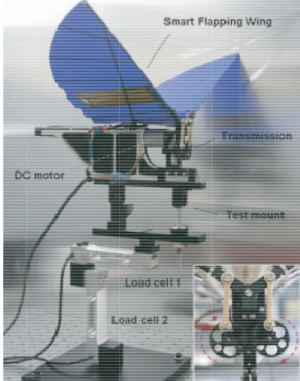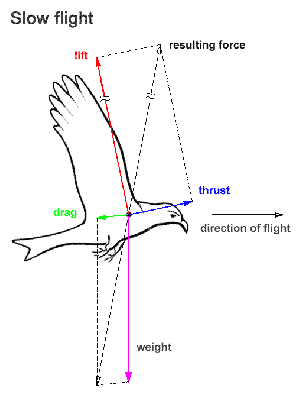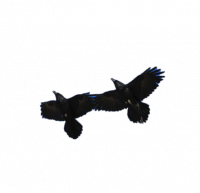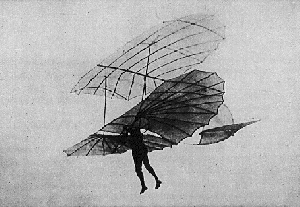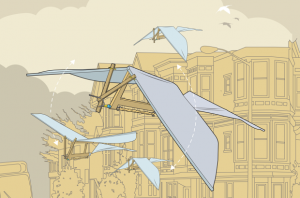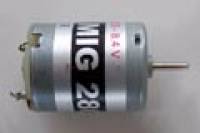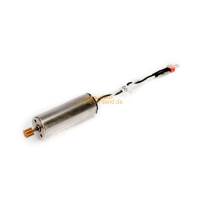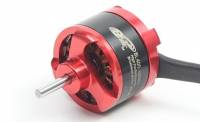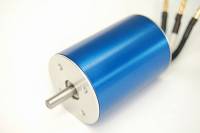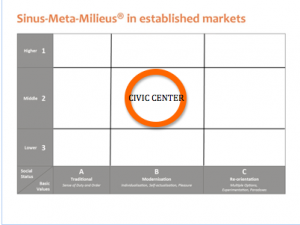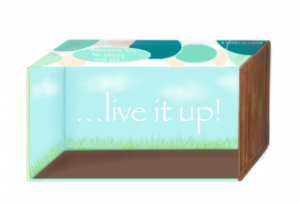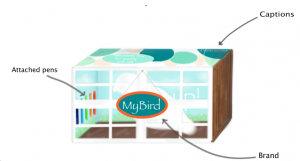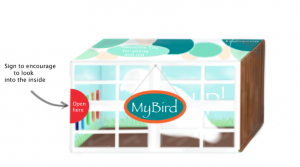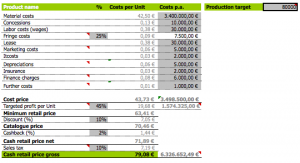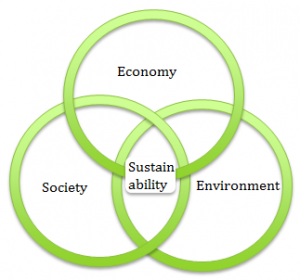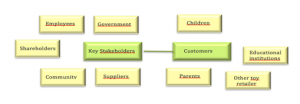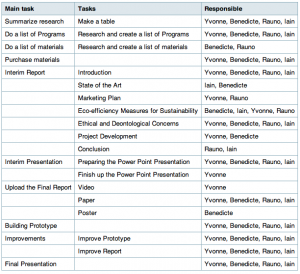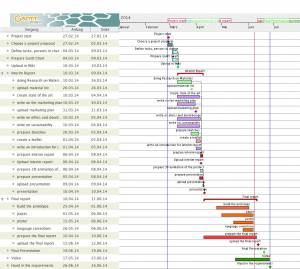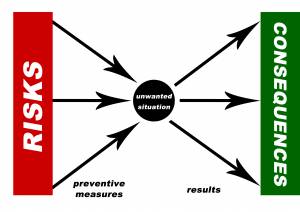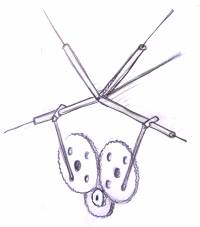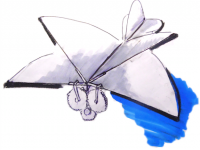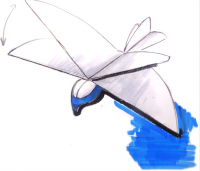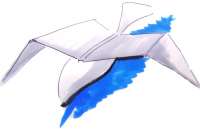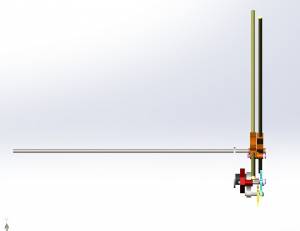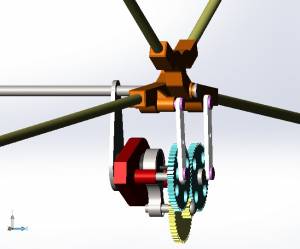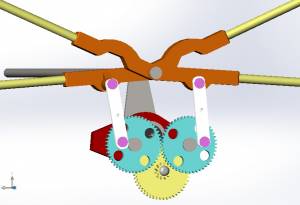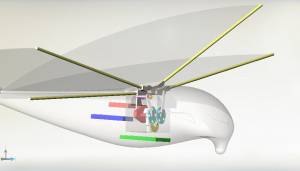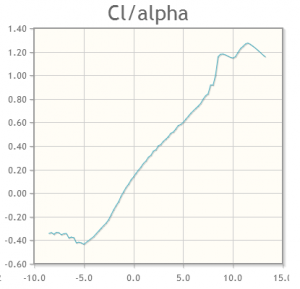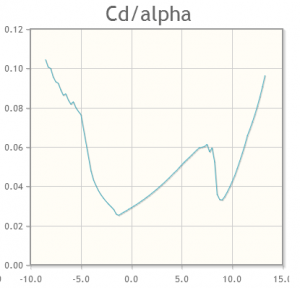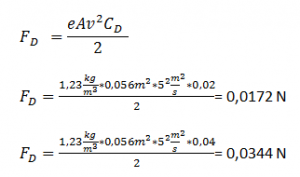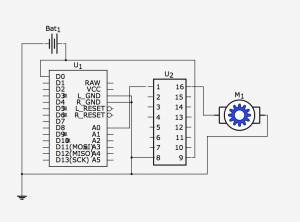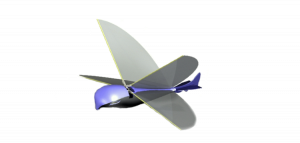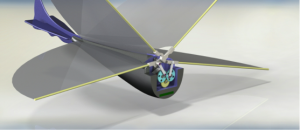Table of Contents
Report
Bio-inspired flying robot
Benedicte Caramin, Iain Dunn, Yvonne Klawikowski, Rauno Ney
Abstract
The goal of this project was to develop a flying robot whose motion came from flapping wings as oppose to propellers. The robot makes use of a biplane design, is constructed from lightweight materials and is powered by a 3.7 V lithium ion polymer battery. The prototype was to be built within a budget of 250 € and had to make use of existing materials and low cost solutions. We aimed to build a robot that was radio controlled and extremely lightweight but we ran in to a number of issues. The robot will still be lightweight but it will no longer be radio controlled. At the time of writing the robot has not yet been assembled nor tested and this makes it hard for us to provide clear results that are anything other than theoretical in this paper. We suffered from time limitations along with setbacks involving the required electrical components. From our experiences we can make a number of suggestions for future research, namely: The addition of radio control, the inclusion of a camera and changing the existing wings from biplane to an articulated monoplane design.
Acknowledgement
Glossary
| Abbreviation | Description |
|---|---|
| °C | Degrees CelsiusDegrees Celsius |
| A | Cross section area (wings): m2 |
| ABS | Australian Bureau of Statistics |
| AS | Australian |
| BTO | Butterfly-type Ornithopter |
| CD | Compact Disk |
| Cd | Drag coefficient |
| CE | Conformité Européenne: European conformity mark |
| CIA | Central Intelligence Agency |
| cm | Centimetre |
| CO2 | Carbon dioxide |
| e | Air density: kg/m3 |
| e-tailer | Online retailer |
| e.g. | Exempli Gratia: for example |
| EC | European Commission |
| EPS | European Project Semester |
| est. | Estimated |
| F | Female |
| Fd | Drag force |
| fig. | figure |
| Fl | Lift force |
| g | Grams |
| GHz | Giga Hertz |
| h | Hours |
| IEC | International Electro technical Commission |
| IR | Infra Red |
| ISEP | Instituto Superior de Engenharia do Porto |
| ISO | International Organization of Standardization |
| JIT | Just In Time |
| Kbit / s | Kilobits per second |
| kg | Kilograms |
| KWh | Kilowatt hours |
| LCA | Life Cycle Analysis |
| Li-ion | Lithium ion |
| Li-Po | Lithium polymer |
| LVD | Low Voltage Directive |
| M | Male |
| Mbps | Megabits per second |
| MD | Machine Directive |
| mg | Milligrams |
| min | Minutes |
| mm | Millimetre |
| NiCad | Nickel Cadmium |
| NiMH | Nickel Metal Hydride |
| NIST | International Guide for use of International System of Units |
| NZS | New- Zealand’s |
| PDCA | Plan, Do, Check, Act |
| PEST-analysis | Political, Economical, Social and Technical analysis |
| Potmin | Minimum power |
| PS | Polystyrene |
| RC | Remote Controlled |
| RF | Radio-frequency |
| Ro HS | Restriction of the use of certain Hazardous Substances |
| SMEI | Sales and Marketing Executives International |
| SRDs | Short Range Devices |
| SWOT-analysis | Strength, Weakness, Opportunities and Threats analysis |
| TSD | Toy safety directive |
| TV | Television |
| UPS (systems) | Uninterruptible Power Supply |
| USB | Universal Serial Bus |
| v | Velocity: m/s |
| V | Volt |
| W/kg | Watts per kilogram |
| Wh/kg | Watt hours per kilogram |
| Wi-Fi | Wireless Fidelity network equipment |
List of figures
Figure 1: Example prototype
Figure 2: Gantt chart
Figure 3: BTO
Figure 4: E-bird
Figure 5: Dragonfly
Figure 6: Del-fly
Figure 7: Micromechanical flying insect
Figure 8: Bird flight analysis
Figure 9: Wings 1
Figure 10: Wings 2
Figure 11: Wings 3
Figure 12: Wings 4
Figure 13: Human wing model
Figure 14: Non motorised ornithoper
Figure 15: IR impulses
Figure 16: Wing movement
Figure 17: Estimated resident population of Australia since 2001
Figure 18: Amount of money spent per child per year in Australia
Figure 19: Population Density Australia
Figure 20: Civic center
Figure 21: Packaging
Figure 22: Packaging details
Figure 23: Packaging details
Figure 24: Sustainable development: where economy, environment and society overlap
Figure 25: Key stakeholders
Figure 26: Gantt chart
Figure 27: Risk analysis: bow tie model
Figure 28: Quickdesign 1: mechanism
Figure 29: Quickdesign 1 exterior
Figure 30: Quickdesign 2 mechanism and exterior
Figure 31: Prototype in solidworks
Figure 32: Prototype in solidworks
Figure 33: Prototype in solidworks
Figure 34: Prototype with shell in solidworks
Figure 35: Eppler 193 Airfoil
Figure 36: Lift coefficient
Figure 37: Drag coefficient
Figure 38: Circuit diagram
Figure 39: Render 1
Figure 40: Render 2
List of tables
Table 1: Team members
Table 2: Ornithopter types summary
Table 3: Battery Types
Table 4: Engine types
Table 5: Competitors
Table 6: SWOT-analysis
Table 7: Average weekly earnings, Australia
Table 8: Price plan
Table 9: Action plan
Table 10: Future costs
Table 11: Task division
Table 12: Material list
List of equations
Equation 1: Lift force formula
Equation 2: Drag formula
Equation 3: Minimum power formula
1. Introduction
1.1 Presentation
When we started our project at the end of February, we were put into multidisciplinary teams to work on it together. We were given a list of optional topics and chose the ‘bio-inspired flying robot’. The entire semester we worked on this topic from several viewpoints, to create our own product.
Our team consists of four people with different backgrounds and different professions.
Iain is a mechanical engineer in training so he should mostly be in charge of the electrical plans for the robot. Furthermore his mother tongue is English so he will be in charge of correcting the writing.
Next is Bénédicte, she’s a product designer. Which is why she will take care of the design, the advertisement, logo and brand marking.
Our third member is Yvonne who is in sales and marketing engineering, here for she will focus on the marketing planning and management.
Last we have Rauno, who is in materials engineering, so he will be in charge of the material list. (table 1)
Table 1. Group introduction
1.2 Motivation
We were presented with several project proposals from which we chose to develop the bio-inspired flying robot. This project appealed to us because it would be challenging, yet possible. Furthermore we found it to be a very interesting topic since none of us has any experience with robotics but all are interested in the field of mechanics. Besides our interest in robotics, we liked the bio-inspired aspect of the proposal, since nature creates the most elegant and intelligent solutions to its problems.
1.3 Problem
The main goal of the project is to create a robot that can fly up, and land safely but it is not allowed to contain any kind of propeller. For this we need a motor, a wing construction, a frame, a body, a rechargeable battery, and some other electrical components, which are listed in the material list. The wings should make a flapping motion, based on the movements of an animal of our choice. We should find a niche for the product and include a purpose. There were several questions that we asked ourselves at the beginning: What kind of similar products are on the market already? What are we able to create in the short time and with our budget of just 250 €? How should the wings motion really function? How frequently do the wings have to flap? To what extent does the weight affect flight? It is now up to us to answer these and many more questions and to find the necessary solutions.
1.4 Objectives
The general objective was designing, developing and implementing a bio-inspired flying robot. One line of research and development in robotics that has received increased attention in recent years is the development of biologically inspired robots. [1]
Whether robots that use legs, wings (fig. 1) or fins as a means to implement locomotion, the idea is to acquire knowledge of biological beings whose evolution took place over millions of years and utilize the knowledge acquired to implement the same methods of locomotion (or at least use the biology for inspiration) on the machines we develop. It is believed that through this field of study we will be able to develop machines with capabilities similar to those of biological beings which will be capable of moving more naturally and which will have greater energy efficiency.
Figure 1: Example of prototype flying robot (Kim, et al., 2007)
1.5 Requirements
There are a number of requirements that need to be adhered to. The basic requirements are to reuse provided components or low cost hardware solutions and to use open source and freeware software. We were instructed to adopt the International System of Units (NIST International Guide for the use of the International System of Units) and to be compliant with the Machines Directive (MD), Low Voltage Directive (LVD) and Restriction of the use of certain Hazardous Substances (Ro HS) Directive. Last but not least our flying robot is not allowed to contain any kind of propeller.
1.6 Functional Tests
Prior to the ultimate functional test (whether or not the ornithopter actually flies) a number of tests that are less likely to damage the ornithopter could be carried out. The system could be rigged to load cells to ascertain whether or not the wings produce enough force to support the weight of the ornithopter. The ornithopter could potentially be tested in a wind tunnel to determine if it is aerodynamic enough to manoeuvre once in the air. Wind tunnel could also be helpful to determine the maximum wind speed, until it is safe to fly with the toy. Also, an autonomy test should be carried out, to know the maximum flying length.
1.7 Project Planning
A visual schedule of deadlines for the tasks and the persons who are responsible for these was created through the use of a tool called the Gantt Chart. Everything that has to be completed up to and including the final Assessment is listed there. We accounted for approximately 20 % more spare time to complete each task because we were aware of the fact that some interruptions or delays might occur. [2]
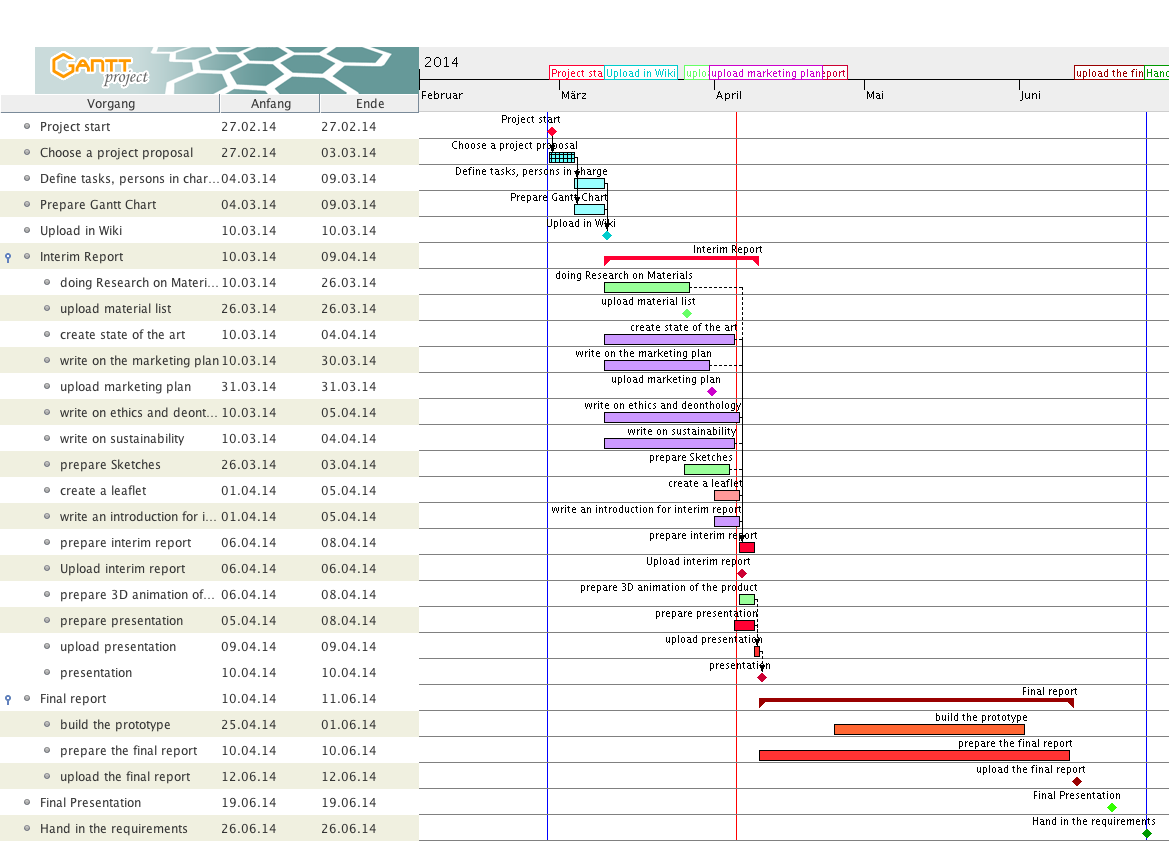
Figure 2: Gantt project
1.8 Report Structure
The report will be divided into 7 different chapters: We start with the introduction, which contains the project summary and our overall planning. Here you can read what the project is about, and how we will manage it.
Secondly, we research the study field in the “state of the art” chapter. Here we analyze a number of the existing models and the current level of technology to give us an idea of what the current market and looks like.
The third chapter covers the market analysis. With the knowledge acquired in the “state of the art” chapter we can situate our product and our company in the current market in that way that makes it possible to devise a strategy to promote our product and guarantee our success.
The fourth chapter covers the sustainability aspects of our design. It is in our best interest to develop an eco-designed intelligent product. To do this we explore our possibilities and assess our choices with a life cycle analysis (LCA). The product should also be eco-efficient. Money must be put to good use to both make profit and sustain the environment. To do this we have to align the 3 P’s: Profit, Product and Planet.
The ethical issues of developing a product are discussed in the fifth chapter. The product needs to be safe for all of its users. To assess the ethics we use the global standardization system (ISO). In this way all users know that the product is of a relatively high quality and that the company is to be trusted. It’s important to consider all parties, such as suppliers, employees, intermediates and customers. The product should be ethically sound in all aspects of its design and conform with the laws of production.
The sixth chapter concerns the project development. Here we report on how we manage the project and develop our prototype. It gives information pertaining to each aspect of the prototype such as materials, capacities and use.
Finally, the seventh chapter reflects on the accomplishments and studies the possibilities for the future. Here we learn how the product could be improved, what possibilities the company has after achieving all its goals, and so on.
In summary:
| 1. Introduction |
| 2. State of the arts |
| 3. Market analysis |
| 4. Sustainability and Eco-efficiency |
| 5. Ethics and Deontology |
| 6. Project Management |
| 7. Project Development |
| 8. Future Developments |
2. State of the Art
2.1 Introduction
This chapter will outline a number of existing systems which are either currently available or which have already been researched. There are a number of systems currently for sale however all of these systems are toys designed for children. 5 systems will be outlined in this report:
- The Butterfly-type Ornithopter
- The Phoenix E-Bird
- The Flytech Dragonfly
- The Del-Fly
- Micromechanical Flying Insect
2.2 Different types
2.2.1 Butterfly-type Ornithopter (BTO)
[3] The system relies upon low wing loading (Ratio of wing weight to area) to function, which makes flight slow but gives a high range of mobility. The wings are extremely light and, in proportion to the weight, very large. This type of wings cannot handle high speeds. In actual butterflies the forward and rear wings act as one, resultantly both wings have been combined in the BTO. The system uses just one pair of wings acting in unison. The BTO’s low weight (0.4 g) and an engine cannot be fitted unless it is scaled up dramatically. There are a number of major problems with this system that would arise when the engine(s) is/are fitted, a notable question is, how much weight can be supported by the system, e.g. it currently weighs 0.4 g, how much extra, unnecessary weight, can be added to the system (without changing the wing size or the materials used) before it is no longer capable of flight. If the amount of extra weight that can be added is low then the robot may have to be massive in order to support the weight of engines, gears and batteries that will have to be added to allow long term flight; how much bigger must the robot be to support this weight and will the structure have to be dramatically changed in order to ensure that it doesn’t break under it’s own weight.

Figure 3: Butterfly-type Ornithopter
2.2.2 Phoenix E-Bird
The E-bird (figure 4) The E-bird is a toy that is currently on sale, it's a toy for children that is priced at around 26,00 €. The flight time is 8 min with a range of 18 m. It is radio controlled and claims to mimic “a life-like flapping wing motion”. Notable problems include the short flight time although in comparison to the BTO this is an extremely long time, there is a lack of information available about this system which may be concealing other potential problems. It weighs just 14 g and charges in 8 min. It cannot perform a takeoff from a stationary position, it must be launched but once in the air it can both dive and climb. Landing is basically a controlled, slowed fall. [4]
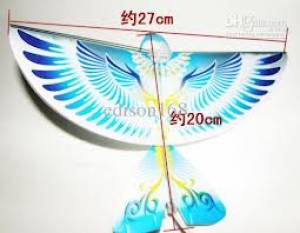
Figure 4: Phoenix E-Bird
2.2.3 Flytech Dragonfly
The Flytech Dragonfly (figure 5) [5] [6] is a product aimed at children that is currently on sale, it is not available in Europe but it would cost approximately 43,00 €. It weighs 28.35 g and is constructed of Expanded Polypropylene for the body, the wings are mylar, Delrin and Carbon Fiber are used in supporting rods and the internal structure. It has some things in common with the E-bird notably the design of the wings; there are four wings in two pairs directly above one another that flap only up and down to produce both lift and thrust.
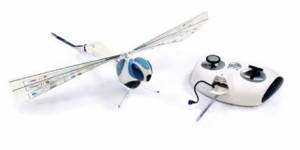
Figure 5: Flytech Dragonfly
2.2.4 Del-Fly
Delft University of Technology developed the Del-fly (figure 6), an ornithopter weighing 15 g, there are discrepancies in the exact cost of the product ranging from 625,00 € to 4316,00 € depending upon which parameters are used. It uses a biplane design, weighs 15 g, uses a lithium polymer battery and can be remote controlled. [7]
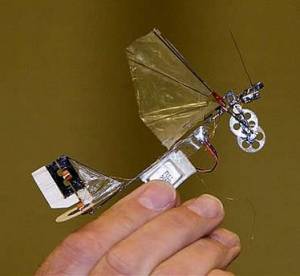
Figure 6: Del-Fly
2.2.5 Micromechanical Flying Insect
The Micro-Mechanical Flying Insect (figure 7) was developed at Harvard University’s School of Engineering and Applied Sciences, it is a tiny robot that weighs just 60 mg (0.06 g) and has a wingspan of 3 cm. The wings have the highest strength to weight ratio of any airfoil in existence, this includes biological airfoils in addition to man-made ones. There is very little control in the insect and it is connected to guide wires for stability and altitude control, however, there is no friction between these wires and the insect [8]
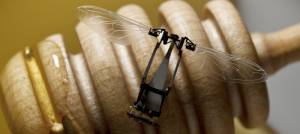
Figure 7: Butterfly-type Ornithopter
2.2.6 Summary
In summary a table (table 2) was created to allow all of the pertinent information to be more easily viewed to facilitate easier comparison of the systems that we analysed
Table 2. Summary of existing flying robots.
| Type | Description | Materials | Total costs | weight | Technique of flight | Remote controlled |
|---|---|---|---|---|---|---|
| Butterfly-type Ornithopter | Extremely lightweight, short flight time, completely mechanical | Balsa wood, paper & steel wire | Unknown | 0.4 g | Two wings flapping in unison at relatively low speed | No |
| Phoenix E-Bird | Lightweight electronic toy, 8 to 10 minute flight time | Polystyrene, Ceramic leading edges, Polythene and the Electronic systems | ≈ € 20 | 14 g | two wings flapping in the opposit direction making it stay in the air | Yes |
| The Flytech Dragonfly | Flying toy aimed at children | Expanded Polypropylene, Mylar, Delrin and Carbon Fibre | ≈ € 25 | 28.4 g | 2 pairs of wings flapping in opposing direction to produce both lift and thrust | Yes |
| Del-Fly | Research Project, Lightweight Ornithopter, however the project encompassed a wide range of other designs | Carbon fibre, Balsa wood, Mylar | 625,00 € | 15 g | 2 pairs of wings flapping in opposing direction to produce both lift and thrust | Yes |
| Micromechanical Flying Insect | Extremely lightweight, mimics the flight of insects with changes in wing shape | Carbon fibre, 1.5 µM polymer Smart composite microstructures | Unknown | 0.06 g | Wings are powered by tiny actuators, wings are extremely strong and flexible | No |
2.3 Bird species
After analyzing the ornithopters that were already on the market, we had to choose a creature to base our model on. When we looked at the slow-motion movements of birds and insects, we decided to build a bird. These are easier to study and build, as most insects have flexible and complicated wing structures. We then had to compare the different types of bird wings and choose a species to focus on.
The general wing dynamics [9] have a few components to consider; our robot will probably just fly forward, as a result we don’t need all of the components from the dynamics analysis. The lift is produced by the air flow on the wing which creates an aero foil. The air pressure above the wing is lower than under the wing, this lift enables the bird to stay in the air. When the bird rotates its wings into the direction of the airflow, it can glide with the resultant angle. The thrust is produced by the flapping of the wings, which creates a circulation which is added to the existing lift. The two stages of flapping are the down-stroke, which provides the thrust, and the upstroke. This thrust overcomes the drag. The drag consists of weight, friction, frontal form and lift-induced drag. (figure 8)
Figure 10: Physics
2.4 Wings
There are 4 different types of wings. [10] Firstly, elliptical wings (figure 9) , which are designed to maneuver in spaces with a lot of obstacles. Examples of birds that have this type of are crows, ravens, blackbirds, sparrows, and thrushes such as the American Robin
Figure 11: American Robin's wings
Secondly, high speed wings (figure 10), which are short and pointed, to create rapid wing beats. Examples of birds that have this wing type are swifts, ducks, falcons, terns, and sandpipers
Figure 12: Swifts, ducks, falcons & sandpipers
Thirdly, there are the high aspect ratio wings (figure 11); these are far longer than they are wide and are used for a slower flight, they are not too energy consuming, and are used for gliding. Examples of birds with this wing type include eagles, most hawks, and storks
Finally there are the soaring wings that are often seen on bigger birds (figure 12), Finally there are the soaring wings that are often seen on bigger birds, these wings have curved tips to use the airflow optimally during flight, however, they need a longer taxi (runway on the ground before launching) to get up in the air. Examples of birds with this wing type are albatrosses, gulls, and gannets
2.5 Ancient experiments
Another interesting topic to analyse in this section is the ancient models for human wings (figure 13). A lot of great minds have tried to build bird like wings on a human sized scale. Most of the models use a propeller for staying in the air, and many other just enable the human to float for a while. The bird wing movement which is very complex creates an equally combination of forces, it is therefore not easy to copy. [11]
Figure 13: Human wings
In smaller models there are many examples of motorized and pure mechanical flapping wings. An example of a non motorized ornithopter (figure 14) is the following:
Figure 14: Rubber-band Ornithopter
In the link below [12] we found a tutorial for making this ornithopter with materials that can be found lying around the house. The result is a bird that flies for a little while before crashing, due to the power of the rubber band. The sizes of the wings gave us an indication of what would fit for our bio inspired ornithopter. The electrical devices were discussed in the electronic state of the art chapter.
http://makezine.com/projects/make-08/building-an-ornithopter/
2.6 Battery Type
When we researched the batteries used in remote controlled toys, we noticed that most of them use a type of Nickel battery. In the table below (table 3), we compared a number of the most common battery types. [13]
Table 3: Battery types
| Properties | Lead Acid | NiCd | NiMh | Li-Ion | Li-Po |
|---|---|---|---|---|---|
| Energy Density (Wh/kg) | 30 | 50 | 75 | 130 | 110 |
| Cycle Life | 250 | 1500 | 500 | 700 | 500 |
| Fast Charge Time (h) | 8-16 | 1 | 2-4 | 2-4 | 2-4 |
| Overcharge Tolerance | high | moderate | low | very low | low |
| Self-Discharge | low | medium | high | low | low |
| Nominal Cell Voltage (V) | 2 | 1,25 | 1,25 | 3,6 | 3,6 |
| Charging Current | low | high | medium | medium | medium |
| Operating Temperature | -20 to 60°C | -40 to 60°C | -20 to 60°C | -20 to 60°C | 0 to 60°C |
| Maintainance every … (days) | 180 | 30 | 90 | never | never |
| Price | very low | low | medium | very high | very high |
Lead Acid — most economical for larger power applications where weight is of little concern. The lead acid battery is the preferred choice for hospital equipment, wheelchairs and emergency lighting.
Nickel Cadmium (NiCad) — mature and well understood technology but relatively low in energy density. The NiCad is used where long life, high discharge rate and economical price are important. Main applications are two-way radios, biomedical equipment, professional video cameras and power tools. The NiCad contains toxic metals and is environmentally unfriendly.
Nickel-Metal Hydride (NiMH) — has a higher energy density compared to the NiCad at the expense of reduced cycle life. NiMH contains no toxic metals. Applications include mobile phones and laptop computers.
Lithium Ion (Li‑ion) — fastest growing battery system. Li‑ion is used where high-energy density and low weight is of prime importance. The technology is fragile and a protection circuit is required to assure safety. Applications include notebook computers and cellular phones.
Lithium Ion Polymer (Li‑Po) — offers the attributes of the Li-ion in ultra-slim geometry and simplified packaging. Main applications are mobile phones. [10]
In conclusion, a Lithium Ion Polymer battery was chosen because of its adaptability to a wide variety of packaging shapes, reliability, and ruggedness. An important factor was also its low weight.
2.7 Communication Systems
As we are going to use a remote control for our Bio inspired ornithopter, there are several communication systems, which make the system work by its signals. We are going to investigate the most popular ones.
2.7.1 Infra-red
An IR (Infra Red) remote control (figure 15) uses light to transmit signals to the addressed device. It works as follows: the remote control (the transmitter) sends out pulses of infrared light that represent specific binary codes. These binary codes correspond to commands, such as Power On/Off and Volume Up. The IR receiver on the addressed device picks up the signal from the remote, decodes the pulses of light into the binary data (ones and zeroes) that the device's microprocessor can understand. The microprocessor then carries out the corresponding command. [14]
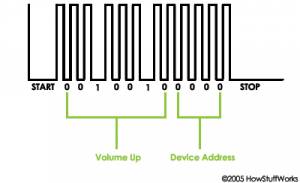
Figure 15: IR impulses
2.7.2 Bluetooth
A Bluetooth connection is wireless and automatic. The newer Bluetooth 2.0 has a maximum transfer speed of 3 megabit per second (Mbps). Bluetooth transmits data via low-power radio waves. Bluetooth allows users to connect to a wide range of devices at one time without cables, and potentially without actively initiating the connection. It communicates on a frequency of 2.45 GHz. One concern when using such a system is privacy. As Bluetooth operates in the globally available 2.45 GHz frequency, it is conceivable that an unintended recipient could intercept a signal. The range of a Bluetooth device is roughly 10 m; for this reason we decided against using Bluetooth for our remote control. [15]
2.7.3 WiFi
WiFi technology uses radio signals for communication, typically operating at a frequency of 2.45 GHz. Electronics that are “WiFi Certified” are guaranteed to interoperate with each other regardless of brand, as long as they use the same version of the technology. A prominent advantage is that Wi-Fi allows cheaper deployment of local area networks. Spaces where cables cannot be run, such as outdoor areas and historical buildings, can also host wireless LANs. [16]
2.7.4 ZigBee
ZigBee is characterized by low-speed , low cost and extremely low power . It is mainly used for telemonitoring with automatic transmission of measurement data and for remote controls. The transmission speed which it achieves is 2.4 GHz 250 kbit / s (in the lower frequency bands 20 and 40 kbit / s), its range ranges from 10 to a maximum of 75 meters. The low energy consumption is worth highlighting; using the stand- by mode and activating it rarely, the ZigBee system can be powered by two ordinary AA batteries for up to two years. [17]
2.7.5 Radio-frequency
Radio-frequency (RF) remote controls are very common. Radio-controlled toys have always used radio remotes. The RF remote sends out radio waves that correspond to the binary command for the button you're pushing. A radio receiver on the controlled device receives the signal and decodes it. The problem is, that you need to use different frequencies otherwise two devices with the same frequency would cause interference and neither would work. The advantage is their range. They can transmit up to 30 m from the receiver (the range for Bluetooth is shorter), and radio signals can go through walls. [18] This benefit in addition to the fact that it is cheap is why we decided to use RF for our E-Bird.
2.8 Power systems
An ornithopter requires power to fly, commonly this power comes in the form of a motor powered by a battery or fuel. Around about 100 watts per kilogram of power is required from the motor to make a mylar-winged ornithopter fly.
2.8.1 Rubber Bands
Ornithopters powered by rubber bands are the easiest type of ornithopter to design and build. In these systems a rubber band does the job of the entire power system, acting as both the motor and the battery. The rubber band is twisted to produce potential energy, when this energy is released it converts to kinetic energy, it produces a large amount of torque, which makes the gears move and the wings flap. As we have to build an electronic ornithopter, this power system is of no use to us. [19]
2.8.2 Electric Motors
Most radio-controlled toys such as: cars, helicopters and ornithopters are powered by an electric motor and battery. There are a great deal of motors on the market all of which vary in almost every conceivable way; This did not make it easy for us to choose one. We are going to list four types of electric motors that may be used in an ornithopter. There is an optimal way of loading the motor which is dependent upon the type chosen. The general rule to follow is: as the wings get bigger the motor must turn slower with higher torque; ornithopters with smaller wings must have a motor operating at a higher rate of RPM. (table 4)
Table 4: Engine types
In our case the brushless coreless motor makes most sense since it is cheap, light and still energy efficient. Since the body is easy to take apart, it is also easy to replace the motor when ceases to function. [20]
2.9 Conclusion
Our ornithopter will be modeled on a white dove.(figure 16). This seemed like the best choice since it makes the semi-folding movement of the wings that enables the bird to fly upward. The size of a dove seems like a suitable goal with our budget and the ergonomic limitations of a child’s toy. In our marketing plan we decided to give the children the opportunity to design their own flying bird with crayons or paint. The product should be white to start with. We will operate our bird with a Radio Frequency remote control. [21]
Figure 16: Movement
Marketing Plan
3.1 Introduction
“Marketing is the process of planning and executing the conception, pricing, promotion, and distribution of ideas, goods, and services to create exchange that satisfy individual and organizational objectives“ Bennett 1988, p. 115 [22]
The ultimate goal of marketing is to make the product sell itself. The aim of marketing is to understand the customer and his needs as best as you can, so that the product fits their needs exactly.
To achieve that we must first understand the market and the customer’s requirements. With that knowledge we are able to create a customer orientated marketing strategy, which allows us to develop an integrated marketing program. The next step will be forging solid relationships with our customers in the hope that one day they will become profitable.
3.2 Product description
Our product is the Bio-inspired remote controlled ornithopter. The goal is to create a flying robot that mimics the movements of birds. Our product makes use of a radio controlled remote and an aerodynamic design to do this.
The flying dove will have replaceable wings that the kids can design themselves, allowing it to be either; a colourful peacock or a green dragon.
Additionally there will be a camera within the flying bird allowing the children to go on adventures and play detective.
We want to make an elegant and interactive toy for children. For that reason we are going to focus on the market for children’s toys in Australia because we learnt that since 2012 the total turnover of the toy industry in Australia was 84.1 billion €. Six years prior it was only 67 billion €. As the toy industry is experiencing such rapid growth, it seemed appropriate to engage in this market.
According to research from global industry analysts the expectation of the global toys and games industry is expected to hit its highest selling point in 2015. This big rise is due to the changing tastes of the toy consumer. Children now prefer more sophisticated and electronic toys.
3.3 Environmental analysis
In the following section relevant influencing factors of the micro- and macro-environment are examined, in order to discover where the best opportunities and most dangerous hazards of the business lie. This will help the business to compete more effectively against its rivals and it enables the organization to take advantage of emerging strategic opportunities.
3.4 Analysis of the Macro-environment (PEST-Analysis)
The analysis of the external business environment is the analysis of the market’s driving forces and the effects that these factors have on our company but upon which our company does not have any influence. This analysis will show which macroeconomic factors are of particular importance and what impact they will have on the company and the entire industry. The PEST-analysis is made up of the political and legal forces, the economic environment, the social and cultural forces and the technological environment. [23]
3.4.1 Political environment
In Australia there has been some controversy about marketing to children. At first the government wanted to ban junk food advertising to children because there was a marked increase in the levels of childhood obesity. A lot of politicians took a closer look at this type of advertising. Children have product preferences that can change very quickly. They have a big influence on their parents and they manage their own pocket money at a continuously earlier age. The government took this into concern because children up to 8 years old are too young to understand advertising. They don’t understand the concept of persuasion, and it is concerned unethical to take advantage of this lack of judgment. [24] The restrictions to this type of advertising are not particularly effective, the only thing that was forbidden was fast food marketing for children and advertising on school grounds. Since there has been so much controversy on this issue and for our own ethical reasons, it’s best to target the parents. [25]
3.4.2 Economic environment
Although the world’s economy is still in crisis, the global toys and games industry is expected to hit the 100 billion € mark by 2015. Consumers taste is always changing and they are expecting more innovative and sophisticated toys. Children are also becoming increasingly accustomed to changing toys more frequently. Our main target, Australia, has the second highest per child rate of money spent on toys, although manufacturing rates for toys are extremely low there.
3.4.3 Social environment
We are using forecasts to understand the trends and patterns in historical data. The demographic change that Australia is currently experiencing is a factor, which makes the implementation of our remote controlled toy easier. The Australian population grew from 21,262,641 in the year 2009 to 23,432,792 in the year 2014 and the population growth rate is 1,11 %. The birth rate is 12.23 births /1,000 population. [26] These facts alone reassure us that the toy industry should not have any worries about a lack of consumers because the population is steadily growing. [27] (figure 17)

Figure 17: Estimated resident population of Australia since 2001
3.4.4 Technological Environment
The product life cycles of technologies are steadily getting shorter, this causes companies problems; they have to catch up with the technical advances and constantly have to fight to stay ahead of the curve. The rapid changes in technology are causing traditional marketing to adapt too. It is necessary to always keep up with new trends and to be aware of competitors offering new products. Computer chip embedded toys have replaced the wind up and battery operated toys of the past. These are good conditions to enter the market but to be competitively viable we have to continuously innovate. [28]
3.5 Micro environment
For the analysis of the micro environment we use “the porter five forces analysis”. This consists of five topics that represent all of the parties that are involved with or influence a company. The parties are the new entrants, the substitute product of services producers, the consumers, the suppliers and the competitors.
3.5.1 The threat of new entrants – low
A growing market attracts many new firms. This threat can be prevented with barriers in the market, like patents and government restrictions.
Barriers to entry are still low as there is a lot of competition and there’s not a lot of variation between the products. It is said that the toy industry is already well established. The increasing demand for electronic toys however, provides an opportunity to differentiate from the others. We can conclude that all these factors do not exclude the possibility to enter in the industry because an innovative electronic toy has a significantly large chance to succeed. Traditional toys remain popular but there are a lot of suppliers for these and not a lot of opportunities to innovate.
3.5.2 The threat of substitute products or services – very high
The threat of substitute/ alternative products in this industry is very prevalent. Toys and games are goods used for entertainment purposes. Looking at a wide range of goods which are on the market to satisfy the needs of the customer makes it hard to believe that there is still a niche for something new! It is not just Dolls, board games, video games or remote controlled toys that people use to entertain themselves; it is also cinemas, outdoor sports or swimming baths for instance, that satisfy their need to be entertained. Due to the fact that the varieties of entertainment outwith toys and games are immense, the high threat of substitutes in this market is strengthened further.
3.5.3 Bargaining power of consumers - high
This is the ability of consumers to put a company under pressure and their sensitivity to price changes. In the toy industry this is very influential. Over the last few years the customers (the children) started demanding more and more electronic devices, which forced the toy companies to innovate their products. Children are also very sensitive to trends and television, and can therefore, quickly change their preferences due to a new TV series for instance. The other customers, in this case the parents, are very sensitive to price changes and prefer good quality products. The toy market is very seasonal in Australia and 80% of the toy sales take place during the Christmas, summer holidays.
3.5.4 Bargaining power of suppliers - medium
For a new company this can be quite an important factor as it has no power or influence in the supply chain yet. Therefore a lot of research should be done in this area before engaging with suppliers. However the materials required to build the toy are common, like plastic, foil and polystyrene (PS). These materials are easy to acquire and this should make negotiations with the suppliers possible.
3.5.5 Intensity of competitive rivalry
The toy market is, as stated above, very price sensitive. This results in a lot of overseas competition. Most of the toys are imported from low-cost Asian manufacturers, and the local manufacturers only take a small percentage of the market. Excluding the price sensitivity, there is a high demand for quality toys. For our biggest competitors quality is of great significance. To succeed it is best to use innovation, high quality, design and a good promotion plan for launching electronic and original toys. If you manage to provide high quality local components, there is a good chance a brand-new company can increase the size of the local toy market.
3.5.6 Competitors Analysis
We decided to confine ourselves and to focus on existing remote controlled flying toys who are our biggest competitors. Although there is an immense sales pitch offered in the toy industry we believe that people who are willing to buy a toy already made a decision of the type of toy they are looking for. We compared our three biggest competitors, which are the FlyTech Dragonfly, the Phoenix E-bird and the FlyZone.
Our competitors have a lot of experience in the market. (table 5) Their sales capacities are much bigger than our expected sales capacity. Clients are already familiar with these brands and the vendors who sell them, which is why we have to do a lot of PR for our product. Our competitive advantage is the possibility of designing your own favourite looks for the bird. This makes the product interesting to a wider range of children, maybe even for all the children in the family. Boys are always interested in remote controlled toys, younger girls are fascinated of having their own little flying birdie and their older sisters would really enjoy showing their drawing skills on a pair of wings. Our special feature, the integrated camera, will also meet the needs of the children raised in a digitized world.
Table 5: Competitors
| WOWWEE FlyTech Dragonfly [29] | Wild Creations Phoenix E-Bird [30] | FlyZone [31] | |
|---|---|---|---|
| Product’s strategy | WowWee is a leading designer, developer, marketer and distributor of innovative hi-tech consumer robotic and entertainment products. | Their commitment is to provide customers with products that bring us closer to nature, take us outdoors, foster personal engagement with one another, and encourage the pursuit of adventure and knowledge | They are offering a different approach to r/c flying toys. Power Core, from the airplane, can be easily removed and installed into other airframes |
| Price strategy | Sophisticated toys made of high quality materials | Quality toys for affordable price | Varienty of different types of airplanes for affordable price |
| Distribution strategy | Products are sold in the online store and there is also a retailer in Canada | Also their own online store. In addition, available on amazon and ebay | Many retailers all over the world in 50 countries. Also an online store |
| Strategies, that support the sales. | The safety and privacy of children who play with WowWee toys and who visit their website is very important to them. For years WowWee has been a name that parents can rely on. | Their moto is: „The Health Of Our Planet And Its Inhabitants Depends On Clean Air, Clean Water, And Clean Food.“ The most important value for them is well-being of our planet. | Very informative homepage, where it is easy to find the nearest dealer, or buy the product from the online store. |
| Strengths/weaknesses | Founded in 1988, so they have 26 years of experience. Numerous awards from reputable organizations and publications | Green values and commitment to animal care. Still small and a developing company | Known and sold worldwide, including Europe, Australia, Asia, Africa, and America. |
| Desgin | Bio-inspired, both, the movement of the wings, as well as as the overall shape | All the products are designed to copy the natural looks as much as possible. | Changeble design without buying new electronic components |
| Functions | Entertainment | Entertainment and ecological thinking | Entertainment, as well as primary engineering skills. |
3.6 SWOT Analysis
From the micro-environment analysis we can make a structured overview of our products prospects and current assets. We listed the strengths and the weaknesses of the product, at this moment in time. From the information gathered we can list the opportunities and possible threats for the future. (table 6)
Table 6: SWOT analysis
| S (strengths) | W (weaknesses) |
|---|---|
| Price/affordability | Seasonal market and product |
| Flexible product | Limited time and budget for development |
| Niche product: not existing like this on the market yet | Lack of experience |
| Quality (labels and standards): upcoming demand | |
| Large promotion budget | |
| O (opportunities) | T (threats) |
| Launch in Australia during summer/Christmas season | Mature markets |
| Online presence due to own web-designers | Asian low-cost competition |
| Engage in a strong supply chain | Entering the market during off-season |
| Follow trends in marketing: TV and music | Flying and racing simulation video games for Wii can take away potential buyers |
| Using social networks as advertisement | European crisis - economic depression |
| Adults also use robotics: possible target |
3.7 Strategic objectives for our project
To produce the product to the best of our abilities that will constantly generate profit in long-term, we have to strategically plan for the future, our company has to improve and grow constantly. To accomplish this we set a list the goals and objectives for the future:
- Develop an adapted and improved model every 2 years
- Build up long-term relationships: Always think about the consumer’s needs and happiness. Focus on different profiles, offer good after-sale services
- Expand our company to Europe’s leading countries after 3 years
- Establish long term relationships with manufacturers and traders
- Establish long term relationships with manufacturers and providers
- Adapt to the changing industry
- Focus on maintenance of machinery and infrastructure: usual safety, accuracy and quality check-up.
- Set money aside for annual surveys, ask customers for their opinion
- Frequent use of the design and testing team.
- Differentiate products by wealth-class in 3 years
3.4 Market Segmentation
There are many influences upon the decision-making process when the consumer is buying a product. It can be current trends or the status of the particular brand in the society, which influence the choice. Sometimes the parents of a child choose a special type of product for their children because it is very famous in the society or maybe because the friends of the child also have that toy. As the barriers to enter the toy market are low, there are a lot of competitors. For that reason it is necessary to remain competitive by defining a special target group.
In order to define our target market it is necessary to divide the market into different segments using appropriate criteria relating to needs, characteristics and behaviour of prospective customers. Market segmentation can be conducted differently depending on the product itself. Mass marketing for example would be undifferentiated targeting and is rather more linked to products that satisfy basic needs like food or health-related products. In contrast to mass marketing, the three other types of marketing make use of market segmentation (target group marketing, niche marketing and one-to-one-marketing) resultantly they are more helpful for products which have specific features such as ours. We decided to divide the market into different segments (or potential ‘target groups’) identifying the ideal one.
Levels of Market Segmentation:
- Mass Marketing
- Undifferentiated targeting of all market segments, “One size fits all” Philosophy
- Segmenting Markets
- Adaptation of the product targeting and the marketing mix for one or more broad- based market segments
- Niche Marketing
- Adjustment of product targeting and marketing mix for narrowly defined sub-segments of the market
- Micromarketing
- Proposition of customized products and an individually tailored marketing mix (“one-to-one marketing”)
We will concentrate on the Niche Marketing, the segmentation will be based upon certain criteria. For our market segmentation we considered the following criteria: Geographical-, demographic-, psychographic characteristics.
3.8.1 Geographical characteristics
We picked the Australian market because Australia is the country which spent the second highest amount per child on toys (fig. 18), it has perfect climate conditions for our RC flying bird, which is a toy to play outside with and which ideally should be used when the wind is calm.
After asking a few boys when they played with remote controlled helicopters the most we concluded that the weather was more important than the age.
Q: When did you play with these toys the most?
Oliver (M, age 21, Belgium): A: When it’s sunny I suppose. If I had one now I would play with it all the time)
Anton (M, age 22, Belgium) A: We tried to win it at the fair every year and then played with it until it broke. (fair = in summertime)
Victor (M, age 24, Mallorca) A: I have one now, I can control it with my Iphone. I use it a lot but more when it’s sunny.
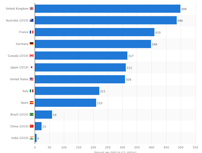
Figure 18: Amout per child spent on toys (in U.S. dollars)

Figure 19: Population density [28]
As already mentioned, since the Australian children spend the greatest amount of money on toys we want to start our business there. (figure 18) [31] Because of the climate and the fact that our product is a summer product, we decided to launch our bird around Christmas time (summertime in Australia) (Figure 20). The population density is 2.91 people/km2, which may sound rather sparse but if we consider how big Australia is, 7,692,024 km2, we are definitely moving into a market that guarantees us the potential to acquire customers. (figure 19) [32] [33] We are going to distribute our RC Flying bird through intermediaries. Although Perth is located on the west side we still believe it to be a profitable sales market. We will run a webpage to serve the rest of the country.
3.8.2 Demographic characteristics
We will target modern, middle class parents, who are the so called “civic centre”. (figure 20)
The unemployment rate is low and the average income is almost 4300 € per month for fulltime adults (table 7). With this income they are able to afford our toy, which is situated in the middle-price-class and targets at the middle class citizen. At around 30 years the women have their first child. This is an age where we can be sure that they are still in touch with the technological advances.
An RC toy can be seen as an educational toy. Nowadays parents want their children to improve their skills in a very young age but they sometimes do not take into account that their child’s social skills can suffer from that.
Our toy is family oriented and is designed to encourage socializing. Children should play outside much more often. An RC toy also enhances electronic skills and improves hand eye coordination. Young children for instance probably own a lot of electrical devices, such as a PlayStation, apple gadgets, computer games etc.
Their neuromuscular movements are well developed at that age and they can handle a lot of remote controlled devices. They can read and have a basic knowledge of symbolic communication on devices but RC toys are not only fun for children; many adults enjoy them as well.
Table 7: Average weekly earnings, Australia
| November 2013 | Nov 2012 to Nov 2013 | |
| $ | % change | |
| Males | ||
| Full-time adult average weekly ordinary time earnings | 1532,10 | 2,7 |
| Full-time adult average weekly total earnings | 1621,50 | 2,6 |
| All employees average weekly total earnings | 1347,90 | 1,8 |
| Females | ||
| Full-time adult average weekly ordinary time earnings | 1270,50 | 3,3 |
| Full-time adult average weekly total earnings | 1287,30 | 3,3 |
| All employees average weekly total earnings | 872,60 | 3,9 |
| Persons | ||
| Full-time adult average weekly ordinary time earnings | 1437,00 | 2,9 |
| Full-time adult average weekly total earnings | 1500,10 | 2,9 |
| All employees average weekly total earnings | 1114,20 | 3,0 |
Figure 20: Civic centre
After many years of investigations certain characteristics for the Civic centre have been established, which correspond to our target group. They are as follows:
3.8.3 Psychographic characteristics
- Social class: Employees, clerks, technician, many part-time workers and housewives.
- Personality: Performance, precaution, orderly conditions, balance of work and leisure, security, alignment on the expectations, Pursuit of adaptation, respected citizen, obtaining acceptance in society, open for something new.
- Lifestyle: family outing, walking, hiking, home and garden, reading, jogging, tennis, squash, cycling, cinema, theater.
3.9 Positioning
“Positioning starts with a product, a commodity, a service, a company, an organization or even a person…But positioning is not something you do with the product. Positioning is what you do with the idea of the interested parties.“ Ries & Trout, 1981 [34]
We are going to find an unoccupied position and fill it with our new Product by the identification of possible competitive advantages to build an intended position.
3.9.1 Differentiation through the product
- Our benefits are the attached tools, and extra wings to let the child design his bird the way it wants to have it, and the integrated camera to make playing with the toy an adventure. With these attachments we are innovative, there is no toy on the market which offers that.
- We keep the quality high to convey safety to both, parents and children.
- Our modern but frisky design aims at girls and boys. The children should feel the urge to play with it. It has light and colorful paints to be an eye catcher.
3.9.3 Differentiation through Image
- Our image will be supported by our catchy logo and our slogan: “MyBird – live it up!”
- We want to make our brand known by presenting our product on fairs, organizing competitions, using the Internet for advertisement (cookies, YouTube-Videos, social media like Facebook, Twitter, Instagram, etc.), distribute brochures in front of stores and broadcast a short but memorable commercial on the TV.
3.10 The Marketing-Mix
The Marketing Mix [35] is a set of marketing tools that the company uses to pursue its marketing objectives in the target market. It consists of a combination of the following variables, which are independent:
- Product
- Price
- Place
- Communication
3.10.1 Product
The product policy is the first element in the marketing mix. Besides the customer benefits there are two other elements that are important, which should be taken into account here: the product design and the service. The product design is about the directly visible benefits and the attribute of differentiation. Whereas in the service additional performances, which make our supply unique, have priority. The product policy provides the basis of the marketing mix and therefore the other marketing tools. [36]
The customer benefit – What is the use of the supply to the customer?
To differentiate ourselves from the competition, we offer additional tools to our customers. The remote controlled flying bird will be held simply white and comes together with a second pair of wings, plus supplies to paint it. Furthermore it contains a small camera. The core benefit of our product is the entertainment. In addition to the core benefit our product has a range of additional benefits.
We are stimulating the creativity by leaving the decision of the design to the kids. We want to make playing outside tempting to the Digital Natives Generation. Furthermore the kids will acquire additional skills by assembling and operating our toy. And last but not least, since the toy is an entertainment product that appeals to a broad audience children, young adults, older adults, and even the elderly our objective is to bring the families closer together.
The product design – What does the product look like?
Since our product itself is a simple white dove, we put the focus on the packaging. It can influence a consumer’s decision to buy a product or pass it up. Packaging gives customers a glimpse of the product, and it should be designed to attract their attention. We have to market the product while it's still in the box.
“MyBirds” body is 6 cm wide and weighs 0,050 kg. The wings will be assembled by the customer. Then the wingspan is 28 cm. It is easily breakable and that is the reason why the packaging has to be stable. The bird is fixed in a plastic device so it can not move and break. It is stored in a square box of heavy cardboard. We decided to take the shape of a square because in the transportation it can be easily piled. We exploit the maximum of the loading capacity. The sides of the box will look like a treasure chest and the top of it has blue ornaments, which to no not facilitate the impression of the dove being caged in a box. Since you associate a dove with peace and freedom we tried to import as much nature as possible.
The front of the box looks like a window and contains a see through foil, so the customer has to look inside or even open the window to get a better impression of the toy. While taking a look inside it is as if he or she would look to the outside of a house. (figure 22)
The labelling (figure 21, 22 & 23) on the high-value package details some of the bird´s attributes. „MyBird“ is highlighted in big letters on a sign, which is attached to the window. And the descriptive tagline ”…live it up“ is written down on the inside of the box. At the back of the package there is a picture of the bird in action with captions as „Design it the way You like it“ and „Awesome toy for young and old”. These descriptions are charted to allure the consumer to purchase it because the product features will satisfy some need or want. In addition the labelling is also printed at the back. There is one that says that it is not a toy for kids under 10 years and another one the “CE” which stands for the quality seal.. We are using colours, which attract both boys and girls. All in all the design is a modern frisky one.
Figure 21: Packaging
Figure 22: Packaging details
Figure 22: Packaging details
The product service: What additional services do we offer?
The level of awareness is not high yet because we are start ups. This leads to the fact that we have to offer a lot of services. Furthermore we have to differentiate ourselves from our competitors, so we decided to set our service quality standards higher than theirs.
To attract the customers, we are offering a six months guarantee on the camera, this will be also mentioned on the packaging because it affects the buyers decision process. Furthermore we provide an e-mail service for upcoming questions. This is low in price and we try to stick out with our promptness. But right here we have to mention that we will have a commercial video, which shows detailed how to operate our toy, so as to reduce the urge to ask questions.
Supplementary the speed of the delivery plays an essential role. Therefore we have negotiated favourable terms with “Zookal“, which makes it possible to us to deliver the package right after purchasing it by the drones of this company. “As one of the few countries Australia allows commercial drones activities,“ says Zookal chief Ahmed Haider. [37]
At long last we attach an operating instruction, which has the same structure as the one that IKEA uses. It is easy written and contains pictures.
The key to success is building relationships that go beyond one-time projects and provide value to these clients on a consistent, ongoing basis. To assure that, we first of all need to keep our clients informed, because they depend on us. Making regular communications with them is one of our top priorities. This includes updating them on various projects but not just through the Internet. Brochures and posters are sometimes even more effective than online advertisement.
Another important aspect is honesty. No long-term relationship survives if the two parties aren’t honest with each other. To provide a product or service our client needs, our chief responsibility is to be open and honest in all of our dealings.
Clients are smart, they know when they are being manipulated. Even telling a “little white lie” about why we failed to return a phone call can damage the reputation.
Furthermore it is significant to meet our deadlines When we say we are going to do something, there should be no questions in our client’s mind that this might not be true. By committing to a deadline, you relieve the client of the worry that a vital product or service might not be ready in time to meet his or her needs.
And last but not least, think of clients as more than just “clients”. The more we identify with our client as a person, the bigger is the chance to make money and the stronger the bond between us will grow.
We are using the cloud-based Customer Relationship Management, which allows us to automate and synchronize certain customer-related processes and activities – primarily sales activities, but also those of marketing, customer service and technical support. The benefits are, that we manage customer contact information, improve handling of leads and prospects, optimize product mix sold to customers and improve accuracy of sales forecasts.
3.10.2 Price
The price policy (table 8) is an important tool in the marketing mix. As a directly recognizable, distinguishing feature it is the price, which serves the interested customer as an orientation guide in their purchasing decision. In general, a higher price is associated with higher quality while a low price is connected with low quality.
We are aiming to the middle class and started the pricing as follows. We first calculated the cost per unit (product = unit; service = hourly rate). We assume that the production cost of the bird in China will be 15 € and the camera costs 24 € so we have material costs, which include 3,50 € of transportation per unit, of 42,50 €. We added the requested profit per unit and the profit margin to thus determine the retail price.
Table 8: Price plan
We will sell our product for 80,00 € . It is about 40 € more expensive than our competitors, but it is mainly the camera which makes the price go up.
If somebody purchases a higher amount of our toy (≤ 50 Units), we will reduce the price. The more they buy, the cheaper it gets. Our minimum retail price will be 65,90 € though.
What is mentioned more detailed in the „Place“ section is that we are selling our toy ourselves through the internet and to wholesalers. We have to pay a high attention to that point. To avoid a conflict with the wholesalers we have to sell our product at a lower price, as we sell it on the internet, to them.
3.10.3 Place
Distribution is not just about how we bring our offer to the customer. It comes along with the question where we offer our product and what marketing channels we use. The main question is, where do our target customers buy and according to that, which distribution channels are suitable for us.
Online selling is usually more successful than selling things in stores - this is not particularly surprising, since nowadays many people buy their products and services online. First of all because it is stress free, they can purchase 24/7 and most of the time the products are cheaper than in the stores because the suppliers have minor costs.
We are selling this product through our own online shop and in addition we make it available through Internet-based “e-tailers” such as Amazon.com and Mayer.au. Furthermore we are contacting the ten biggest toy´s wholesalers: [38] [39]
- Mystique Toys
- Wild Republic
- Children's Palace WA
- Kangaroo Creek Gang Australia
- Club Toys
- Korimco Soft Toys
- Wild Republic
- Bees Knees 4 Kids
- Timbertop Toys
- Dormar Indents
We sell directly through e-mail and on fairs for wholesalers. That saves us a lot of costs, which we would otherwise invest in two different kinds of advertising: one for the parents and one for the wholesalers. Since the wholesalers inform the retailers about the new products, its uses and changes in their prices and furthermore assist the retailers in advertising and selling of the products, building up a long term relationship here is as well very important. There are several ways how we will develop the relationship. We will meet with them in person, communication through telephone and e-mail is fast but not as affective as a face-to-face conversation.
3.10.4 Communication
The key question is, how we can influence the buying decision of your target customers in a positive way. Advertisement is a tool, but there are also other image-enhancing actions, which are taken for our business model. We are getting into action. Because the dove is an animal which facilitates peace and harmony we will organize some design competitions in hospitals and give them away as gifts. Furthermore we will also make contests in schools and fairs to improve the level of awareness. All of that will be filmed by the attached cameras oft he bird and cut to a commercial video, which will be published in the TV and on YouTube.
Since social media has become a platform that is easily accessible to anyone with internet access, is an inexpensive platform and attracts attention and encourages readers to share it with their social networks we put a lot of effort in social media marketing. We will concentrate on Facebook, Twitter and Instagram at the beginning. Furthermore we will make commercials through banners and cookies on well-known internet pages.
Furthermore we will have a stand in bigger stores, like Toys R Us or in malls. We will have tumblers who animate the children to play and paint and we will give away a CD, which contains a short Video of that experience. Detailed information will not just be sent through mails to the customers, we will also forward flyer to them, in that way they have something in their hands.
Additionally we are thinking about the implementation of an advertisement in the Guerrilla Marketing style in which we bear on the camera of our product and take a mickey out of the observation scandal of the last few months.
3.10.5 Action plan
Table 9: Action plan
| Time | This activity must be done |
| Daily | Checking + answering e mails |
| Checking the orders and adapting them | |
| Checking clicks on website | |
| Weekly | Market research |
| Sending mail adverts | |
| Planning additional communication strategies | |
| Monthly | Checking the quality of the manufacturing |
| Meeting clients and suppliers (strengthen relationship) | |
| Update the website | |
| Yearly | Stocktaking |
| Annual financial statement | |
| Statistics and new strategies |
3.8 Budget
We have 5000 € available for marketing purposes. Our marketing budget will include all promotional costs, including marketing communications like website development, advertising and public relations. The costs of employing marketing staff and utilizing office space will not be taken into account at this time because we are at the very beginning of our business and therefore have not enough funding to pay our staff and to lease an office.
The following table demonstrates the costs that will occur in the year 2015. (table 10)
Table 10: Future costs
Our main goal is to make our brand known through the different marketing measures. When we reached this, we must expect further expenses in the following years, since the competition is not sleeping.
3.9 Strategy Control
With the marketing companies pursue special objectives, which should be coordinated with the corporate goals. Increasing sales and the value of the company has usually priority. Our marketing efforts are focused on the following overall objectives:
- the sale of products to be increased
- the awareness of the brand (product or company) should be improved
- customer loyalty and customer value should be increased
- the image of the company is to be improved
The marketing controlling then measures the effect of marketing activities that have been done. In particular, it is to be measured quantitatively how brand building, advertising, or public relations are affecting net income. Moreover, other actions, such as product design and product improvement, pricing and price adjustment as well as distribution channels and their usage can be checked. Therefore our adjusted surveys, which mirror the satisfaction of our customers could be taken into account as well.
Our purposes are rigorous control measures to closely monitor the product quality, our brand awareness, our brand image, and the customer satisfaction. This will enable “YourToys” to react quickly in correcting any problems that may occur. Other early warning signals that will be monitored for signs of straggle from the plan include monthly sales and monthly expenses. And furthermore the market share in percentage, sales per year or return on investment (ROI) are other methods for controlling.
It is necessary to reach at least the break even point. The break even point represents the sales amount that is required to cover total costs (both fixed and variable). There is no profit at break-even. In our case the break even point is reached when we sell toys by the end of December 2015.
3.10 Conclusion
Marketing is not only about selling and advertising. This is only the tip of the marketing triangle.
Today, marketing must be understood in the new sense of satisfying customer needs. If we understand consumer needs, develop products that provide superior customer value, distribute and promote them effectively, these products will sell easily. So, marketing can be seen as a process by which companies create value for customers and build customer relationships in order to capture value from customers in return.
For us as a start up it is very difficult to make our brand known in this world where it seems that everything is already existing and there is no more space for something new. That is why it is all the more important to invest most of the time in an accurate business plan before going on the market.
Because one of the most common reasons for premature failure is a lack of planning. By creating our business plan, we test our business idea on the feasibility and the economic potential. In addition, we determine the financial needs and thus avoid mistakes in the foundation. Furthermore working customer orientated from the beginning will increase our chances of getting a positive access into the market.
A good start, however, does not mean that you should sit back. Once the customers become aware of our toy, it is about building a customer relationship and maintaining it. We achieve that by our many services that we offer. But it is also necessary to continuously improve the quality and safety of our toy. The more experiences we have, the more know how we gain and this can be implemented positively into our business.
Since we offer our toy through the internet, we have a little buffer as far as the product amount is concerned. We will start with 1000 birds and depending on how fast they sell we will produce more. Our intensive after sales management will support our customer relation and consequently our goals for the first two years.
4 Eco-efficiency Measures for Sustainability
4.1 Introduction
Sustainable development is a process which must constantly evolve in order to satisfy the needs of people in the present, without compromising the ability of people in other parts of the world, or future generations, to satisfy their needs too. Four megatrends influence and determine the lives of the people and the economy all over the world: demographic changes, urbanization, climate change and globalization. They are also drivers of our business, as they open up new markets and business opportunities. However, they harbour risks to which we must address responsibly.
As a company that attaches great importance to sustainability, we are going to meet these challenges by seizing opportunities and minimizing risks. The results of the consumer and trade study “Toys go green - Sustainability in Toys” proves that not only quality and the game concept convince the consumers to buy a toy, it is also the sustainability which counts to their three most important purchasing criteria for toys. The resulting added value for toys influences the buyers’ attitudes and purchasing behaviour. This gives us a great deal of motivation to put as much effort as we can into satisfying our customers. [40]
In addition, using an environmental friendly material combined with ecologically aware manufacturing process and recyclable packaging for almost every customer is an aspect for sustainability. 89 % deem wood to be the most sustainable material, followed by cotton (22 %) and recyclable paper (13 %). As we can see the environmental sustainability takes priority. The protection of natural conditions is a prerequisite for economic and social stability. Our principle is to be responsible when dealing with our employees, our social environment and our natural resources. In the following sections we will explain how we will meet the requirements of the three pillars in greater detail.
Figure 25: Sustainable development: where ecological, economic and social aspects overlap
What is people’s understanding of sustainability? (figure 25) In November 2010, 450 consumers in three different cities and small towns across Germany and 150 toy vendors were interviewed. The results were that 54 % of the purchasers connect natural and renewable raw materials and an ecologic manufacturing development processes with sustainability. 44 % deem long lasting products to fit these criterion and 21 % highlight the educational value gained by playing with the toy. [41
In addition using an environmental friendly material combined with a ecology-minded manufacturing and a recycable packaging for almost every customer is an aspect for sustainability. 89% account wood for fort the most sustained material, followed by cotton (22%) and recyclable paper (13%). As we can see the environmental sustainability takes priority. And the protection of natural conditions is a prerequisite for economic and social stability. Our principle is to be responsible in dealing with employees, with our social environment and with the natural resources. In the following sections we will explain how we meet the requirements of the three tiers more detailed.
4.2 Our Company
4.2 Our company “YourToys” is now a well known manufacturer and retail distributor of toys in Germany. We started with an online webpage which was aimed at only the Australian market. After a while we made the decision to put our focus on Germany because the turnover in Australia did not meet our expectations. In 2016 our first store was opened in Hamburg and since then we have grown rapidly throughout Germany with a total of 10 retail outlets, 1 manufacturing site and 1 distribution warehouse in 2020. Our wide range of approximately 400 product lines are marketed under the brand “SmartToys4you”. Our affordable toys are designed to educate children of all ages. They are designed and manufactured in Germany to ensure high quality and safety. The most widely used components in our products are plastics and small amounts of steel, which we get from our listed suppliers in Germany.
4.2.1 Transparency Transparency is a fundamental requirement of sustainable business practice and corporate responsibility. This means publishing the information and details that are important for the stakeholders of a company or organization. Providing reports on the company’s sustainability is a core business practice because it can provide advantages over competitors and it can even increase the credibility of a company
4.2.2 Key Stakeholders
Figure 25: Stakeholders
CUSTOMERS – children (figure 26) Children are the key user of our products. Their concerns are essential in determining the design and the marketing of all our products and services.
CUSTOMERS – parents, other toy retailer, educational institutions (figure 26) Since they are the buyers of our products, we have to make sure that our products meet the requirements of our customers - being safe, durable, educational and capturing the child’s imagination while still getting value for money. Otherwise they will seek alternative product choices.
SUPPLIERS ( figure 26) Due to our high dependence on deliveries, we need to keep our relationship with our suppliers good and respond to their requests and concerns. We need to work with them to meet changing product needs, quality requirements and production schedules. It would cost too much time and money to change the supplier because the procedures are already well integrated.
SHAREHOLDERS (figure 26) As they are the owners of parts of the Company, shareholders need accurate, up to date and reliable information regarding their financial investment.
EMPLOYEES (figure 26) Our employees are our greatest assets. Without their dedication and experience we cannot achieve and maintain our vision of sustainability. Which is why we should endeavor to grant their requests, within reason.
COMMUNITY (figure 26) We need to constantly identify and satisfy the changing expectations of the community.
4.3 Environmental sustainability
The environmental sustainability describes the aspiration to preserve nature and the environment for future generations. This includes the preservation of biodiversity, attempts to stop climate change, the maintenance of cultural and natural areas in their original form and in general being careful not to disturb or alter the natural environment. Ecosystems are only able to cope with a certain amount of change before either long-term or permanent damage is caused. It is not simply about reducing the amount of waste we produce or using less energy. Instead it is about developing processes that will lead to our business to becoming completely sustainable in the future. It requires a long-term strategy as well as systematically integrated management and systems to both monitor and control the company’s sustainability practices. [42]
4.3.1 Processes
YourToys has the certification of using ISO 14001:2009 and ISO 9001 standards to maintain our objective of environmental sustainable processes through the entire production process. That means that from the product design, through the research and development phase to the manufacturing and distribution we will focus on limiting damage to the environment. The ISO 14001 defines a focus on a process of continuous improvement as a means to achieve the objectives, defined in each case, in relation to the environmental performance of an organization. The continuous improvement process is based on the method Plan-Do-Check-Act, PDCA. [43]
The quality management standard ISO 9001 is nationally and internationally the most common and most important standard in Quality Management. It specifies the minimum requirements of a quality management system, to be implemented by companies to meet customer requirements and other requirements for the product or service quality. [44]
Our materials are sourced from local, listed suppliers, who also use environmentally friendly methods themselves. The reason behind this decision is that we want to keep the environmental impact as low as possible and this is achieved through the short transportation distance.
A contract with our suppliers with the following requests was drafted:
They have to increase the use of recycled or recyclable materials, to design products using recycling principles and properly identify all plastic and polymeric parts. Furthermore they have to keep the packaging at the minimum and if possible use recyclable packaging to reduce the waste. Lastly and perhaps most importantly they must adhere to their ISO 14001; environmental management system.
To help them meet those requirements, we provide support and training.
4.3.2 Pollution control
Pollution has a lasting impact on the environment. To avoid causing pollution we must first aim to minimize waste before it is created. Furthermore we are improving our pollution control strategy, which means that we first collect and then dispose of the waste at an appropriate recycling or processing facility. At our stores we have on site recycling units to enable our customers to return their packaging to the store. We also encourage them and the suppliers to recycle where appropriate, especially the batteries.
The main drivers behind all of these methods are long term cost savings and positive public relations.
4.3.3 Renewable energy
Due to change attributable to urbanization; notably climate change and the regulations that came with it, the customer’s requirements changed in terms of what was expected from toys for kids. A company’s value is increasingly defined by the sustainability of products. If we remain sustainable we see the potential for us to remain competitive.
We are using a low energy production techniques. Our factory is located close to the North sea, where it is always windy, in an attempt to take advantage of this location to lower our electricity bills we spent 250.000 € on a wind-turbine. The greenhouse gas emissions from this turbine are only 12 g CO2/kWhe, in stark comparison to Coal’s emissions of 1001 g CO2/kWh. [45]
It is our belief that the costs will be recouped in savings in the coming years. To accelerate the return on our initial investment we have moved into a well-insulated building to save on heating and cooling expenses. This building was already equipped with the newest equipment all of which are always switched off when they are not being used.
We decided to remunerate 50 % of our staff’s expenses on public transportation to encourage our employees to come to work using more environmentally friendly methods. We also offer car pooling services and encourage the use of bikes to travel to work. All of these schemes seemed difficult and expensive to implement into our business however it is our belief that in the long term they will result in noticeable cost savings. [46]
4.4 Natural resources
4.4.1 The framework We try to use as many eco friendly materials as possible. This is not a simple task as we must use lightweight materials because the weight of our remote controlled toys is of paramount importance. We chose mylar for the wings and Bio-plastics or bio-based Polymers for the shell. The product will be easy to disassemble in the event that any of the materials have to be replaced. We offer a 6 month guarantee on our products, in the event that one of our products is defective we will try to reuse as many materials as possible to repair it. We cannot, unfortunately, use biodegradable materials for the interior components of this product because the ones that exist on the market are ill suited to our design. In an attempt to make up for this we will use a mono-material called Cargo Frame for our packaging. The paper-based material will keep the product safe and secure during transport and eliminates the use of pesticides needed when shipping with wood. The mono-material is highly rigid, which removes the need for additional frames, lowering the weight and the usage of more material. The material produces less CO2 than other industrial packaging materials, is produced from recycled paper, is reusable, and is also easily recyclable. [47]
4.4.2 Batteries The production of a battery uses 50 times more energy than they can deliver. This is extremely inefficient. For this reason we will use rechargeable batteries in our toys. Although they are more expensive, they can be recharged many times and are therefore seen sustainable and above all environmentally friendly. [48]
4.5 Life Cycle Analysis
Life-cycle assessment is a technique to assess environmental impacts associated with all the stages of a product's life, including raw material extraction, material processing, manufacture, distribution, use, repair and disposal or recycling. [50] Choosing the materials was done by considering all the important factors: price, location, impact on nature, weight and mechanical properties. We were given already a set of manufactured materials, while choosing them, we put great efforts into saving resources by getting as much materials from the same dealer as possible.
When it comes to everyday use, criteria such as power consumption and durability might be analysed. According to these factors the most suitable components were chosen. The gear motor is a brushed inliner, that is the most suitable option for ornithopters, choosen by the neccesary power, that fills our needs
The component, that has the biggest impact on nature is probably the battery, we decided to use LiPo battery, because of its high energy density as well as relatively low self-discharge rate. The battery does not require any specific maintenance and it can work in wide range of temperature. It does not contain toxic metals so there is no risk of harm. Li-Po batteries cannot be thrown away as usual waste because there is a risk of exploding when incinerated, they should be taken back to the service point. [51]
The outer shell of the bird is made of Polysterene. Unfortunately most polystyrene products are currently not recycled, but however, afrer the material goes through an initial compaction process, it becomes a recyclable commodity of high value for producers of recycled plastic pellets. Foam scrap can also be turned into products such as clothes hangers, park benches, flower pots, toys, rulers, stapler bodies, seedling containers, picture frames etc. [52]
The wings are made of Mylar. The proper name of the material is BoPET (Biaxially-oriented polyethylene terephthalate), it is a polyester film made from stretched polyethylene terephthalate (PET). [53]
There are two ways to recycle polyethylene terephthalate or PET or polyester: 1. The chemical recycling back to the initial raw materials- it becomes cost-efficient only applying high capacity recycling lines of more than 50,000 tons/year. Such lines could only be seen, if at all, within the production sites of very large polyester producers.
2. The mechanical recycling where the original polymer properties are being maintained or reconstituted- These kinds of processes are typical of small and medium-size industry. Cost-efficiency can already be achieved with plant capacities within a range of 5 000 – 20 000 tons/year. BOPET-film of low thickness (Mylar) is produced from virgin polyester only. [54]
4.6 Social demands
Social sustainability requires that both the collective knowledge of society and its ability to work towards common goals are maintained. An individual’s needs: health and well-being, nutrition, shelter, education and cultural expression should be met. [48]
4.6.1 Employees Our employees are our a valuable investment and an extremely knowledgeable source of information. Therefore they should be our highest priority we must make them feel valuable and appreciated, to do this we must cater to their needs. We try to make the atmosphere as familiar as possible, even the boss can be called by his first name. Every employee has the opportunity to communicate formally and informally any concerns with the managers at any time, their worries no matter how trivial are listened to. This information, provided that it is not of a personal nature, is then summarized and reported at the monthly management meetings. This allows our staff to take part in the company’s decision making process.
We employ almost an equal amount of men and women. We offer flexible working arrangements for our staff to help them manage their familial, educational and social commitments
Through schemes, providing health & safety training and ergonomically designed workstations, we reduce health-related risks and costs. This allows us to prevent an increase of sickness-related absence from work.
The opportunity to learn never goes away – We have job specific training where our staff can get familiar with the use of new equipment. Sales training and technical training are also offered in addition to general training such as safety training and environmental training.
4.6.2 Suppliers Since the abuse of human rights scandals are often big news we want to eliminate the risk of having suppliers in our supply chain who do not live up to basic human rights. For that reason we have meetings once per quarter with our key suppliers where we talk about working hours, child labor, health and safety, discrimination and privacy.
4.6.3 Customers
To increase the satisfaction of our customers and to enhance the quality and safety of our products and services, we believe that the opinions of our clients should be integrated. Our performance depends on them and for this reason we will implement a customer survey where they can express their satisfaction. We know that not everybody will fill in the survey but if even just 30 % of them complete the questionnaire covering issues such as product quality, product safety, product labeling, customer service and suggested areas for improvement, it will be an enormous help for us to improve ourselves.
4.7 Economic demands
Economic sustainability is the term used to identify various strategies that make it possible to use available resources in the most advantageous ways. The idea is to promote the use of those resources in ways that are efficient, responsible, and likely to provide long-term benefits. In the case of a business, it calls for using resources in a way that allows the business to continue to function over a number of years, while consistently returning a profit. [49]
In the past we have given donations to kindergartens and schools throughout Germany but the kindergartens and schools must have been active in environmental and health programs such as: waste and electricity minimization and recycling.
As was already mentioned in the environmental sustainability section, we encourage our customers to recycle the toys. If they are collected in a good condition, they will be donated to the less fortunate: children who would not otherwise have access to high-quality educational toys. Plastic toys in poor condition are recycled and used in the production of new toys. We invest a high amount of money in our employee training program in the environmental and health and safety area.
We also provide opportunities for further development of career opportunities through leadership programs. It is important to us that our employee has knowledge of our sustainability values. We ascertain that our programs and staff initiatives evolve and support the sustainable development.
4.8 Conclusion
Sustainable development is considered the model of the 21st century. It requires a development that meets the needs of the present generation without compromising the ability of future generations to meet their own needs. We start by being as sustainable as possible by choosing suppliers who fulfill our requirements. Then by using renewable energy, recyclable materials, and sustainable packaging.
By our integrating aspects of environmental, social and economic impacts, we obtain benefits such as risk reduction, cost reduction, innovation and the public’s perception of our company is increased. We continuously strive to improve our sustainability performance and further develop our strategy, defining it more precisely. What we know now, is that for our customers less is more and we try to keep this in mind all the time.
We would like to conclude with a quote from Mahatma Gandhi: “The world has enough for everyone's need, but not for everyone's greed.” - Gandhi
5. Ethical and Deontological Concerns
5.1 Introduction
This section will discuss ethical issues surrounding our product and other more general ethics on a range of issues. In most cases you will encounter some ethical conflicts and difficulties in the process of developing, launching and selling a new product. These conflicts can often be very complicated, to be able to find the right solution and have everyone’s best interests at heart, you need a concrete set of ethics.
A large part of ethical development lies in common sense and a basic set of moral standards. Since these are relative we are in need of a general set of rules to guide us. These rules will help you to reach conclusions and make decisions. This is the key to responsible decision making for every business. When ethical rules are applied both internal and external stakeholders will be satisfied with the results. To do this properly, there are many ethical standards in existence that are considered universal and apply to people around the world. These standards should be considered carefully.
It is important to remember that everything a company does will effect others. These choices can have an impact upon the company’s image. This image influences their place in the market. Good business ethics are essential and will have positive effects on your enterprise. High ethical standards will provide you with the following benefits:
- Improved employee and organizational morale
- Increased ability to attract new customers
- Improved customer loyalty
- Reduced risk of negative exposure and public backlash caused by poor ethics (bad press)
- Attraction of new stakeholders
- Making a positive impact on the community
5.2 Engineering Ethics
In order to ensure that our product benefits these positive impacts, we need it to be of high quality. Smart technology improves lives and satisfies the customer. It’s the engineer’s job to deliver high quality, efficiently produced new products. Engineers can rely on the Engineering code of ethics to make the right decisions. Engineering ethics, internationally, comprise of three basic core aspects: Competence, Integrity and Sustainability. Naturally these three aspects are explored in greater detail.
Competence relates to all issues on engineers being capable of doing the job that they were hired to do. For engineers to meet this criterion they must: only act within the boundaries of their competence, seek peer review on any issue that causes doubt and they must only act after ensuring that their knowledge in the area was adequate. When help is needed they should consult experts.
Integrity is a core maxim because without it there would be no trust between engineers and their clients and there would be no guarantees of proper conduct or of the engineer’s competence. Of course corruption bribery and fraud are out of the question but there is more to integrity than that. It means that advertising should be true to the actual competences of the product. It also means that an engineer should compete with others fairly and allow the customer to form an objective opinion. Integrity means you should be loyal to your clients and partners. If you treat them as promised and handle all valuable information with care, you will avoid conflicts.
Sustainability is the one area of conduct that doesn’t really relate to the engineer’s general conduct but rather a professional guide that the engineer should be mindful of and attempt to incorporate into all of his/her work. Engineers are also instructed to promote sustainability in order to meet the ethical standards expected and required of them. A smart and sustainable design which keeps production costs low, is good for the environment and gives the company a positive image in the eyes of the consumers.
5.3 Sales and Marketing Ethics
Ethical marketing is defined as: “Practices that emphasize trustworthy and respectful personal and/or organizational marketing policies and actions that exhibit integrity as well as fairness to consumers and other stakeholders in a context of transparency and empathy.” [55]
The “Basic Rule” of ethics in any field is that one should not knowingly do harm. When this rule is applied to marketing it can be interpreted as not doing anything that would disadvantage or deceive the consumer. There are, however, other rules that companies should be mindful of if they wish to be seen as ethical marketers; these rules can be seen on the website of Sales and Marketing Executives International (SMEI). [56]
In marketing you will position your brand in the market and communicate your products and intentions to the public. This has to be considered carefully because false promises are the main source of distrust in a brand. Advertising your product as something it is not or hiding negative aspects and information about your company and products may result in short-term success but in the long run it will cause conflicts.
In the engineering ethics section we state that it’s important to create a product that is well designed. Once you design something of quality, it is not hard to communicate clear and honest information about the assets of the product to the customer.
To advertise our product in an ethical way we should consider the following: As we said in the market analysis, we will target both parents and children. Marketing to children is a delicate issue, since children are sensitive to influences. We will target children from 8 years old. Australian studies have shown that under this age children do not understand the concept of marketing, which is why they should not be exposed to it. The marketing must be restricted to education and fun-related topics. Unethical propaganda could be fast food (Happy meal), violence and war (jet planes or spy equipment).
Furthermore in marketing we should carefully consider our brand name due to copyright laws and make sure we promote totally different features, without insinuating that our competitors would be a bad choice. This means marketing is listing reasons why your brand is the best choice, not listing reasons why other brands are a poor choice.
5.4 Academic Ethics
Academic ethics are not dissimilar to the other types of ethics listed here; integrity is the most valued trait of any academic. Each institution has their own academic ethics, which have to be followed by all students.) Below you find a brief content of the procedures and rules found on www.pmc.edu. Members of an academic community have a responsibility to present work that is truly their own. Cheating and plagiarizing the work of others are serious offenses that undermine the spirit of truth in all areas of academic life. It is the responsibility of the instructor in a particular class to clarify specific applications of the Academic Ethics Policy.
- Plagiarism : Plagiarism is intentionally or unintentionally using someone else’s words or thoughts, without giving proper credit.
- Cheating: Cheating is attempting to present work that one has not performed as one’s own or using forbidden methods to pass an examination.
- Other violations including (but not limited to) falsification of signatures and cooperation in unethical practices.
- Rights and Responsibilities: Student Rights and responsibilities. Students and professors have to follow the academic ethics policy. This code contains rights and obligations of all parties, as well as general academic rules.
- Actions upon violation of the academic ethics policy: there are strict procedures that have to be followed in case of a possible violation
As erasmus students at ISEP, we agree to honor the academic ethics policy of IPP, as well as the general ethic rules for students. [57]
5.5 Environmental Ethics
Environmental ethics are far more abstract than any of the other forms of ethics that are discussed here, principally they concern whether or not we should expand ethics to all areas of the environment, even areas that will never affect humans. These are mostly discussed in the sustainability part. It stands to reason that we have to try to make the product as eco-efficient as possible, even thought that will not be our main marketing propaganda. In summary we will try to apply the following to our product:
- Make it easy for disassembly so parts can be recycled properly
- Ensure high quality to prolong the product’s life
- Select products that are the most environmental friendly
- Maximize production capacity and transportation capacity to produce as much as possible with the minimum time and energy
5.6 Liability
Our product must conform to a number of safety standards implemented in Australia, so people can rely on the quality and truthfulness of our brand. Some mandatory standards on radio controlled toys and electric toys are listed below. We took a look at both global and Australian standards.
- AS/NZS ISO 8124.1:2013
These requirements are listed in the Australian voluntary toy standards. “It specifies acceptable criteria for structural characteristics of toys. Such as shape, size, contour, spacing (e.g. rattles, small parts, sharp points and edges, and hinge-line clearances).” [58]
- TSD 2009/48/EC
Guidelines from the European commission for Toy Safety Directives. Global guidelines for all products described as: “Electronic equipment, such as personal computers and game consoles, used to access interactive software and their associated peripherals, unless the electronic equipment or the associated peripherals are specifically designed for and targeted at children and have a play value on their own, such as specially designed personal computers, key boards, joy sticks or steering wheels.” [59]
- AS/NZS 4268:2012
Radio Equipment and Systems – Short Range Devices - Limits and Methods of measurement.
“SRDs are commonly used for radio communications in Australia and New Zealand. Examples of SRDs are: alarms, baby monitors, garage door openers, data collection systems, retail and logistic systems, telecommand applications, wireless home data telemetry and/or security systems, and keyless automobile entry systems. SRDs use all types of modulation, may be fixed, mobile or portable and have dedicated, and/or integral antennas.” [60]
- AS/NZS 62115:2011 (IEC Text)
Electric toys safety: “Deals with the safety of toys that have at least one function dependent on electricity. Examples of toys within the scope of this standard are constructional sets, experimental sets, models that have a function similar to an appliance or installation used by adults, computer toys, and toy computers. Identical to, but does not contain the text of, IEC 62115 Ed 1.2.” [61]
We will be conform with the engineering code of ethics to reduce or eliminate our professional liability. If the product meets or exceeds all of these standards then the risk of successful lawsuits is greatly reduced. These standards govern most aspects of the above discussed fields.
5.7 Intellectual property
After choosing everything carefully we should register our brand, logo and slogan officially. Our product name will be ‘MyBird’, which focuses on the individualization of toys by decorating the toys before playing with them. The logo is colorful and includes a bird, the slogan is ‘Live it up’, as we decided to focus on the children playing outside and getting maximum pleasure out of the toy. To register them we have to apply on http://www.ipaustralia.gov.au (Australian institute of industrial property) for brand registering and patenting in Australia. [62]
5.8 Conclusion
We are obliged to conform to all of the above listed rules and guidelines. In addition to this we should not stop considering ethics during the process of production. Ethics should always be considered in every step a company and all its employees makes. In the next chapter we will discuss the project management.
6 Project Management
6.1 Scope Management
Scope management involves looking at the project as a whole, defining tasks and goals and then deciding who’s responsibility each task or goal is.
Our task is to build a bio inspired flying robot. That means that it is flying through the use of only its wings and it is not allowed to contain any kind of propeller. The requirements of the project are to reuse provided components or low cost hardware solutions and to use open source and freeware software.
Each goal is set as a milestone in the Gantt chart, which can be found in the “project planning” section (Figure 27) in this chart we outline the three main goals necessary to start working on the project. These goals are: defining the tasks, deciding who will be in charge of each task and finishing the final report and presentation.
You can find the details listed in table 11, which also includes a short explanation why we made these decisions. The project contains a Gantt Chart which is designed to help with rationing the time wisely.
Table 11: Task division
Why did we make those decisions? Our team consists of engineers from multiple fields and the allocation of tasks was done according to each member’s specific skill set. Those who are studying marketing are in charge of the marketing plan, those who are studying engineering materials are in charge of the material list and so on. Another important factor was to divide the work as equally as possible according to the skills of each member.
6.2 Time Management
Time management involves creating an achievable schedule of deadlines for the aforementioned tasks or goals and then making sure that each person responsible for these aspects of the project is capable of keeping to the schedule.
Figure 26: Gantt chart
It has had to be changed several times because it is not easy to plan as many tasks in advance and it is nigh impossible to account for all of the problems that one could run into. Either a lack of motivation disturbs the schedule, unforeseeable circumstances or medical conditions interrupt it. It is therefore advantageous to plan for approximately 20 % more time to every task according to experts in time management.
6.3 Cost Management
Cost management involves simply making sure that the project team keeps to the budget given to them. It requires a great deal of planning to avoid costs spiralling out of control and all essential materials, parts or labour must be planned at the beginning of the project otherwise there will be no way to guarantee that the project will remain within budget.
The costs comprise of a number of different parts: the materials, the labour and the marketing. The budget is as follows: 250 € for materials, 5000 € for the marketing. We have projections of turnover, which will be listed in the budget plan of the marketing section.
Materials
Our budget is 250 € for the materials. They will cost 102,30 €. It is still probable that this price will change if, for instance, the prototype doesn´t work as it is supposed to and we have to purchase additional materials. This is why we tried to keep the costs as low as possible at the beginning.
Labour
We consist of a group of four people. Each one is working round about 270 hours but since this is an academic project there is no salary involved. There are a number of teachers providing us with detailed knowledge about each section in the report. Then there are the supervisors who we see once a week and who help us out when we are stuck. They do not get paid by us for their consultancy.
Marketing
Since we are a start-up we have to invest a lot of money into the marketing. We have to make ourselves known in this mature market and we are doing it through the use of several communication tools. The detailed expenses are listed in the Marketing section but it is not only the communication that costs a lot. Before we start introducing ourselves to the public we have to do a lot of research. It is very time consuming. One must often purchase the reports that are necessary for the secondary research.
6.4 Quality Management
Quality management must be performed at least twice; firstly as the raw material and goods enter the factories to be processed and then before sale of the final product. There can be further testing during the intermediate manufacturing processes. The goal is to prevent the customer from receiving defective or dangerous products, which would cause the brand to lose value, damage it´s image and which could cause a lawsuit.
Technical Quality
We start producing in China because of the low production costs and plan to have our own manufacturing in Germany after around about 10 years when we already have a wide range of distributors who buy our, by then, wide range of products. In China we work only with partners who meet the high quality demanded by us and who comply with the human rights that our society values. For quality assurance, however, all of the materials are tested and certified in Germany before they are forwarded to our customers. Our quality manager coordinates the activities required to meet our quality standards. He is going to make sure that the product meets the customer’s expectations and ensures legal compliance. The Quality will be kept very high because the toy must be safe for kids. These standards are also set by the quality manager. The following tasks are also the responsibility of the quality manager:
• working with purchasing staff to establish quality requirements from external suppliers • making sure that manufacturing or production processes meet international and national standards • defining quality procedures, setting up and maintaining controls to ensure that these procedures are implemented and documenting the procedures • monitoring performance by gathering relevant data and producing statistical reports • preparing clear explanatory documents such as customers' charters.
Communication control
Since we offer a 24 hour e-mail service we hire at least three people, working in three different shifts who will take care of the questions that our customers send to the following e-mail address: service@YourToys.com.
We have one employee who takes care of the e-mails sent to our company intern@YourToys.com and phone calls concerning some internal problems. Finally we have a system administrator who takes care of computer systems and computer networks.
Every employee who takes part in the conferences has access to our drop box in which the agenda for the weekly meetings and the results after the meetings are posted, this allows them to either prepare themselves for future meetings or just stay up to date with the results.
Human Resource Management
We want to minimize employee turnover and want to keep the knowledge up to date. This will not only reduce unnecessary costs but also decrease the risk of newcomers not being able to replace the person who was working in that position before. Therefore the HRM is a very important aspect. Due to our company being a start up the Human Resources duties will be performed by a trained professional.
The HRM will be re-engineering organizational processes, listening and responding to employees and managing transformation and change. In weekly meetings we discuss one or more relating to the development of the project, talk about positive and negative aspects and try to find appropriate solutions. Our meetings will be held face to face but if someone is unable to attend, working abroad for instance, there is a possibility for her or him to videoconference with us.
6.5 People Management
People Management or Human Resources is the aspect of project management that aims to keep all members of the project team working in relative harmony. The aim is to reduce conflict and to alleviate any excess stress that the project may be putting on the people working on it. Project management should also involve making sure that all of the team members are doing the jobs that they are supposed to be doing and reprimanding them if they fail to do so.
The biggest sponsor at the moment is the ISEP. They are providing us with 250 euros which is merely enough to start off but it is nowhere near enough in the long term. For that reason we hired our sales and marketing manager Yvonne, who is making strides to find us new and flexible sponsors who are interested in financing our project. Our project manager in the development phase is Bénédicte, who has knowledge and experience of designing new products. She makes sure that our project is innovative and fits the needs of our customers.
The Project manager in the production phase is Rauno. He already has some experience working in the production and he has the knowledge to make the production as effective as possible.
Quality control has to be done several times during the manufacturing. The manager in this field is Iain due to his tendency to be accurate and precise in whatever he is doing.
Our sales and marketing manager as mentioned before is Yvonne and she is the person who will conduct all communication with stakeholders and customers. She is naturally very good at managing people.
6.6 Communication Management
Communication management simply involves making sure that all of the team members are kept informed of any changes to any area of the project and that they can all be easily contacted in the event that aid or advice is needed. Communication is an essential part of conducting business, and therefore we are using various methods to communicate in our workplace.
Face-to-Face Communication
A lot of our business communication takes place in face-to-face, such as meetings and conferences, which take place every week. The managers and the CEO come together for discussions and solutions.
Email is a preferred method of communication in every workplace as we can also send mass messages with advertisements to our customers. Emailing enhances efficiency because it is quick to send and quick to respond to and you can even include attachments that are essential to the subject being discussed in the email conversation. For our customers and employees we have different email addresses, already mentioned in the communication control segment. As already mentioned in the Communication Control we have three persons, who take care of the 24 hour mail service, that we provide to our customers. With regards to internal mail; each member of staff is responsible for his own email account.
Dropbox
We use drop box as a folder for our employees. Drop box is a home for all our photos, docs, videos, and files. Anything we want to add to Drop box automatically shows up on all our computers , phones and even the Drop box website - we are able to access our stuff from anywhere. It is a fast way to exchange information.
We can invite our employees, customers, providers and stakeholders to any folder in our Drop box, depending of who is allowed to see which information. We can also send people links to specific files, photos, and folders in our Drop box. This makes Drop box perfect for team projects or sharing useful developments with our stakeholders and much more.
Teleconferencing
Communicating through a telephone conferencing system is an effective way of conducting business. When people are not able to attend a meeting in person, the possibility exists to attend through a video conference. If our customers want to reach us by phone, we provide a free number: 0800112233 Our call center agent takes care of that from 10.00 -18.00 o´clock
Facebook / What’s App
Our employees can decide on their own if they want to join our internal group on Facebook and on What’s App. It is cheap, user friendly and furthermore it is a fast way of communicating with each other but nobody is forced to do that.
Feedback
Effective communication between businesses and their employees requires a two-way flow of information. Business leaders need to not only convey messages, they need to receive messages from employees to best understand their perspectives and areas of concern too. Feedback may be delivered directly between employees and their managers or at group meetings, through surveys and polls and through anonymous feedback channels like suggestion boxes or hotlines.
6.7 Risk Management
Risk Management is the art of assessing the dangers and types of risks which are most likely to be caused by any potential project, determining the probability that these risks may occur (as a percentage) then determining whether or not the potential benefits outweigh the calculated risk. [63] This calculation is too complicated and therefor not necessary for our project, so we will discuss only the major risks without assessing them in any great detail. We believe that the best way to do this is through the use of the bowtie structure. (figure 27)
Figure 27: Risk analysis: bow tie model
User-flow:
To define the primary risks, we will take a look at the user-flow. With this user-flow we can decide in every stage of the usage what the possible risks could be. Note: a user-flow is not the same as a life cycle analysis. We will not include environmental issues, financial obstacles or secondary users. This means we only consider the dangers to the primary user: the child.
User-flow:
1. Unpacking
2. Designing the wings
3. Assembling the bird
4. (Re)charging the bird
5. Activation the bird
6. Launching the bird by hand
7. Controlling the bird with the remote control
8. Landing the bird (letting it fall down)
Suitable risks & measures:
1. Choking hazard: Small parts can be inhaled or swallowed and could cause a child to choke. All the parts should be enclosed in the shells, and the shells should be glued shut. Everything will be pre-assembled. Also the drawing pens will be non-toxic in case a child swallows the substance. Furthermore, the product should have a clear age warning. This toy is for 6 years or older.
2. Finger traps: Moving, folding and mechanical parts can cause finger traps which could injure young fingers. In our case it is important to cover the wings’ gear mechanism.
3. Sharp edges: sharp edges or rough surfaces which can cause cuts or splinters. All edges should have a minimum radius of 2mm and the surfaces have to be smooth.
4. Hazard to secondary users: flying toys: Toys can be dangerous when they are too fast, heavy or sharp they could injury children in their flight. We will use a foam bird with a rounded tip and a low velocity to prevent injuries.
5. Electrical toys: Batteries may leak poisons or liquids that can burn skin. High voltage could be dangerous for children. Long cables could cause the children to choke.
We will only use a 3,7 V battery that is built-in and rechargeable by cable. This cable won’t be longer than 50 cm.
6.8 Procurement Management
Procurement Management is an area of Logistics that endeavours to ensure that all goods and materials are sourced in time to be used for the project, it is area that requires a great deal of forward planning and requires margins of error to account for possible delays. Our suppliers are Chinese companies because our production takes place in China. This helps to keep the expenses low for the materials as well for the transportation. Suppliers were chosen according to their prices, quality, delivery times and overall flexibility.
All the electronic components are provided by Jinjiang Meisida Electronic Toys Co. because of their long experience and helpful attitude to clients. Mylar for the wings and foam for the body is ordered from Hongfa Plastic Material Co. We try to keep the number of suppliers low to keep the communication as simple as possible and this company is providing us with both, mylar and foam. Carbon fibre for the Leading edges comes from the company called Henglong Plastic Toys Co. because they were one of the few companies who could offer carbon fibre rods with the necessary shape and size.
Of course we are using Just in time (JIT) manufacturing, which means we always plan all the orders thoroughly. It’s necessary not to waste your storage room on unneeded stuff and keep money tied up. A lot of money can be saved on the delivery costs if all the procurement is done correctly.
In our team Sales and Purchase Manager Yvonne makes sure everything is going well with our procurement. Communicating and finding the most suitable suppliers wasn’t easy in the beginning, our demand for the materials was still small and Chinese prefer to communicate in their own language. After you earn their trust, however, they are very cooperative associates.
The first couple of months were the hardest, most of the companies didn’t reply to our emails that were written in English. After a week or two of waiting, we decided to use help from a translator from English to Chinese, he helped to make the first phone calls and arrange meetings. After that, everything started to move smoothly and cooperation with the Chinese was working well.
6.9 Stakeholders Management
The management of the stakeholders is a very important area in project management as it must be performed very gently. Stakeholders have a great deal of influence and loss of their support could be catastrophic to the project, however, if each of their demands were met there would be no way to manage any other aspect of the project as the areas of cost, time scale, scope and procurement would all constantly be changing.
Teachers’ wishes
First, we took our teachers into concern. They set our goals and grade our product, so it’s important to have a clear view on what they want from us. We read their assignments at the beginning of the semester, we got their feedback after the interim deliverables and finally we sent them the following email to be sure about what they want us to achieve.
Dear professor, As we are getting closer to the launch of our new product, we would like to know what our stakeholders expect from our services. We would like to know what each of our teachers expects us to achieve and if any of you have any additionally questions or comments. Your answers will be filed into the stakeholders management section or our report. Also we will mail a few suppliers and other stakeholders to include their demands. Thank you for your cooperation, Kind regards, Team 3 (Flying robot)
Global project description:
Design, development and implementation of a bio-inspired flying robot One line of research and development in robotics that has received increased attention in recent years is the development of biologically inspired robots.
Whether robots that use legs, wings (see Figure 1) or fins as a means to implement locomotion, the idea is to acquire knowledge of biological beings, whose evolution took place over millions of years, and utilize the knowledge thus acquired to implement the same methods of locomotion (or at least use the biologically inspiration) on the machines we develop. It is believed that in this way we are able to develop machines with capabilities similar to those of biological beings in terms of locomotion capacity and energy efficiency.
• Reuse provided components or low cost hardware solutions; • Use open source and freeware software; • Adopt the International System of Units (NIST International Guide for the use of the International System of Units); • Be compliant with the Machines Directive (MD), Low Voltage Directive (LVD) and Restriction of the use of certain Hazardous Substances (RoHS) Directive.
More detailed demands: • All components must be purchased from Portuguese suppliers. • Delivery consists of a presentation presenting the new product, a model, a project movie, and a report covering all the areas. • All activities must be registered in a logbook . • Task assignment must be included. • Peer assessment is given after the two deliverables.
Other stakeholders opinions
Above all we have to consider our company stakeholders. Our key stakeholders include its customers, employees, retailers, shareholders, suppliers and both the Portuguese and Australian Governments. The customers demand safety, amusement, quality, fair pricing, good services and ethical production. The others ask for ethical treatment and loyalty.
Finally we have to conform to the laws and the global guidelines for production and products. To get a specific idea of what a supplier would want we decided to send an email to a possible stakeholder. We want to include crayons in our toy packaging, we chose to ask a crayon company for their wishes. We chose a local crayon business called Viarco. (http://www.viarco.pt) [64]
Dear sir/madam, We are very interested in cooperating with you for our new product. We will sell a remote controlled flying bird. The idea is that children will be able to design their own wings for their robot. For this we would like to include some of your products in our packaging. We are really hoping you are interested in this cooperation and we have a few questions for you. Can you recommend us any waterproof colouring tools? What would be your demands for our cooperation? Is there a possibility to produce customised colouring tools for our product? We hope to hear from you soon. Kind regards, Bénédicte Caramin, YourToys inc.
6.10 Lessons learnt about project management
In the first few months of the project we learned a lot about team work. All of us have had to work in teams before, which was not always easy but we are now in a multidisciplinary team and it is even more difficult to work efficiently. It appeared to be very important to assign detailed tasks to all the group members, as nobody knows what has to be done and what the specific task descriptions are. This seems a basic rule but as people don’t know each others different backgrounds, it’s harder to rely on others to do things as you had imagined them.
We realized that in the beginning we had no idea we had to take quality and procurement management into consideration, which appeared to be a useful tool.
In short: communication management is the key to success, and this is not only the case in your own team but also outwith the team, between the teachers. If the communication management is not going well, the time management fails too because you greatly depend on one another to meet deadlines.
7 Project Development
7.1 Introduction
After the project was chosen, our project development started, we began by conducting research on already existing ornithopters and different kinds of flying creatures. Flying robots can be divided into two rough groups: insects and birds. We decided to make a bird because designing a bird seemed to be a more interesting and versatile challenge. Our choice was a Dove due to its suitable size and white color that fits perfectly for decorating by the final consumer. The next step, was to search for information about all the components that we were going to need and looking for the best solutions to fit our requirements. We acquired knowledge of different types of batteries, gear motors, remote controlling technologies and of course about light and durable materials. Finally we agreed on the design and could finally make the list of materials. When the materials arrived, the “fun” in the workshop could finally began.
7.2 Architecture
We gathered information from all over the Internet and found a number of different solutions on how to make the bird fly. The following 2 designs (figures 28, 29and 30) were the main ones that we found and thought to be successful. The final selection we made was the biplane, it can be seen in the first three pictures (figures 28 and 29) and the other design will be kept in reserve, in the unlikely event that our bird is incapable of flying, the second design will be investigated. The monoplane in the two last photos (figure 30) is a bit more sophisticated but it's more accurate when it is compared to the flying movement of birds. This monoplane design has articulated wings, which makes the movement more efficient. Flapping frequency can be kept lower (around 4-6 bps) and less energy is consumed. It also looks more realistic when it flies. The biggest problem for us was how to implement this solution; how should the wings bend? Which is why it was left for future development.
Figures 28-30: Design
We drew our prototype in Solid Works. The result looks as follows:
Figure 31: Prototype in Solid Works
Figure 32: Prototype in Solid Works
Figure 33: Prototype in Solid Works
Figure 34: Prototype with shell in Solid Works
The body is 30 cm long and 7 cm wide at the thickest points. The wingspan is 50 cm when thee wings are positioned horizontal and due to the materials it will weigh round about 100 g.
Lift is the force generated by propellers and wings to propel aircraft and keep them in the air. Although Lift is most commonly associated with the wing of a fixed-wing aircraft it can be observed in the animal world as well. In our case lift will be opposing gravity (weight), however when an aircraft is climbing, descending, or banking in a turn the lift is tilted with respect to the vertical. See figures 8, 9 and 10 in the State of Art chapter. [65]
To calculate lift, an aerofoil (shape of a wing) has to be chosen. It must have similar thickness and shape as the one we are planning to build. From Eppler aerofoils, E193 was chosen because of its low Reynolds number that is necessary for flying at low speeds. (figure 35)
The predictable flying speed will be around 5 m/s. It is enough to keep the bird in the air, and also not too fast, that would make it dangerous to operate by children.
Figure 35: Eppler E193 airfoil
For the equation, the lift coefficient has to be chosen from the specific airfoils graph. (figure 36)
Figure 36: Lift coefficient
Calculations have to be done with several coefficients because the weight of the ornithopter can vary. In the event that it will be slightly heavier than expected, the angle of attack (the angle between the body's reference line and the oncoming flow, the graph’s x-axis) has to increase as will the coefficient. [66]
Equation 1: Lift force formula
- Fl is the lift force,
- e is the density of the air (kg/m3)
- v is velocity (m/s)
- A is the cross-sectional area of wings (m2)
- Cl is the lift coefficient – a dimensionless number.
(equation 1)
Drag, also known as air resistance (figure 37), is type of friction that refers to forces acting opposite to the relative motion of any moving object. The drag equation requires the drag coefficient to be chosen, the principle is the same as with the lift coefficient. The horizontal value is angle of attack and if the aircraft is heavier, a bigger angle of attack and drag coefficient must be used. [67]
Figure 37: drag coefficient
Equation 2: Drag formula
- Fd is the lift force,
- e is the density of the air (kg/m3)
- v is velocity (m/s)
- A is the cross-sectional area of wings (m2)
- Cd is the drag coefficient – a dimensionless number.
(equation 2)
After the drag force is calculated it can be used in the minimum power equation, where it has to be multiplied with the velocity. However, this is the simplest approach and the results can't be taken as real. Our motion could never be as efficient as the theoretical results suggest, the bird could never fly with the minimal necessary power. We multiplied the result with a safety factor of 20, after considering it with our supervisors, and decided to use a engine that can provide us with 4 W of power. (equation 3)
Equation 3: Minimum power formula
Our Arduino's output power can reach only 150mA, the motor requires around 1 A to achieve this boost in current a motor driver must be connected to the circuit. Its purpose is to amplify the incoming current enough that the motor wouldn't suffer from a lack of energy.
Figure 38: Circuit diagram
- Bat1: Battery
- U1: Arduino
- U2: Motor driver
- M1: Brushed inrunner motor
7.3 Components
A brushed inrunner type of engine was chosen after discussion with supervisors who confirmed that our plans to use it were correct. To control it, the smallest Arduino on the market was chosen and to amplify its output current, a motor driver has to be used. The battery was chosen according to the most important factors: weight, capacity and discharge rate. A more thorough comparison of motors and batteries can be found in the “State of Art” chapter. A polystyrene body was chosen because of its lightweight, shock absorbing properties and because it can be easily shaped without any specific tools or skills. Mylar is the most common material for wings when it comes to ornithopters, again because of its low density and great mechanical properties. Leading Edges and connection rods will be made from carbon fiber rods. (table 12)
Table 12: Material list
| Detail | Description and link | Quantity | Price (pcs) |
|---|---|---|---|
| Electronics: | |||
| Motor | Brushless inrunner, 3.7 V, http://www.inmotion.pt/store/10-to-1-micro-metal-gearmotors | 1 | 14,95 € |
| Microcontroller | Arduino Pro Mini 328 - 3.3V/8MHz http://www.inmotion.pt/store/arduino-pro-mini-328-3.3v-8mhz | 1 | 8,95 € |
| Motor driver | Motor Driver 1A Dual TB6612FNG http://www.inmotion.pt/store/motor-driver-1a-dual-tb6612fng | 1 | 7,75 € |
| Battery | http://www.hobbyking.com/hobbyking/store/__11874__ZIPPY_138mAh_20C_Single_Cell_.html | 1 | 1,44 € |
| Body: | |||
| Polysterene | Isolamento Chao M 125x60x4 cm from “AKI” | 1 | 5,85 € |
| Wings: | |||
| Mylar | 4 x A4 sheets http://www.amazon.co.uk/A4-Size-Blank-Mylar-Sheets/dp/B004VR2NW6/ref=sr_1_15?ie=UTF8&qid=1399060171&sr=8-15&keywords=A4+mylar | 1 | 4,86 € |
| Leading edges/wing spurs | 2 mm carbon fiber rods from “Aerokit” | 2 | 1,75€ |
| Hinges | To be designed and manufactured in the workshop | ||
| Driving mechanism: | |||
| Gearbox | To be decided upon receipt of motor & calculation of Gear Ratio http://www.ebay.co.uk/itm/58-styles-Plastic-Gears-Cog-Wheels-All-The-Module-0-5-Robot-Parts-DIY-Necessary-/330912750561?pt=UK_ToysGames_RadioControlled_JN&hash=item4d0befdbe1#shpCntId | 2 | 6,00 € |
| Connection rods | To be designed and manufactured in the workshop | ||
| Total: | 59,30 € | ||
Our motor already has a 10:1 gear reduction and the output shaft is spinning at approximately 2000 rpm at 4 V. Our design requires further gear reduction. The final stage will be 3:1, to obtain the desired rotating speed of the final gears. If they rotate at around 660 rpm, the flapping frequency will be 11 flaps per second.
7.4 Functionalities
Our product has flapping wings. 10 min of autonomy for the first prototype. It’s main purpose is to be used as a toy. However, when a camera is attached, (further information about this option is in the Future Developments chapter) it can be used for several different purposes. For example; it could be used by ornithologists to study birds. Our bird looks more natural than any similar flying cameras and it could be easily used to “go undercover“, to integrate among other birds without scaring them away. Additionally “MyBird“ can be used to film mass events. At the moment drones are usually doing it, and they do get a lot of attention from the visitors. We believe that using “MyBird“ would be even more striking and if a small flag with a logo or slogan was attached it would gather a lot of attention allowing it to be used for advertising too. Advantages over the drone are definitely its lightweight (safer for the audience) and its more natural and ecological design.
7.5 Tests and Results
All the characteristics
7.6 Conclusion
Provide here the conclusions of this chapter and introduce the next chapter.
8. Conclusions
8.1 Discussion
The project has suffered a number of setbacks, even now we do not have all of our components and we have not begun to build the prototype. These failings are mostly our own fault, had we ordered things sooner, made certain decisions earlier and been more organized in general I’m confident that these issues could have been avoided. We have, however, learned a lot from this project and we can draw conclusions from our experiences. Most ornithopters fly using a bi-plane system, the prevalence of this design suggests that it is the easiest method of ornithopter flight, any designs for monoplane ornithopters are extremely costly but the research has been done. Initially it was our plan to design something that mimicked as closely as possible the flight of a bird but this proved to be too difficult to design and we decided to build something that resembled existing systems already, keeping our initial plan in reserve. It is unfortunate that as yet we do not know whether or not our design is a success, does our ornithopter fly? Hopefully by the time of our final presentation we will have answered this question.
8.2 Future Development
The next step is to make the bird radio controlled, currently there is no way to control the speed, altitude or direction of the robot. A servo motor should also be added along with a rudder to the tail in order to make the bird turn left and right. Radio control could work on either radio frequency or ,preferably, with wifi because it's more secure and does not succumb to interference. The remote control would be powered by batteries that will also be used to charge the bird. The bird and the remote can be plugged into one another and automatic charging takes place as soon as they are connected.
In the intial planning phases of the ornithopter we planned to include a camera, but flight must be extremely smooth to film, any kind of shaking or unstability would render the recording unusable for any applications where high quality is required. A number of tests should be performed to ensure smooth flight. Weight distribution, wing shape, flapping frequency and type of wings are just some examples that can change the flying properties drastically. Before testing all of those factors in different settings, it's practically impossible to achieve smooth enough flying style.
Articulated wings should be designed in the future. This would be serious evolution because we didn't find any toys or other ornithopters on the market that use articulated wings. A further benefit is that an ornithopter with articulated wings looks as real as a living bird and it's more efficient wing flap movement will make the bird fly with less energy.
Figure 39: Render 1
Figure 40: Render 2
Bibliography
[1] European Project Semester. “Project description” [Online]. Available: http://ave.dee.isep.ipp.pt/~mbm/PROJE-EPS/1314/Proposals/EPS_PROJECT_2014_T3.pdf [Accessed: 8-June-2014]
[2] Wikipedia. “Gantt-grafiek” [Online]. Available: http://nl.wikipedia.org/wiki/Gantt-grafiek [Accessed: 8-June-2014]
[3] Hiroto Tanaka, Kazunori Hoshino, Kiyoshi Matsumoto, and Isao Shimoyama Department of Mechano-Informatics, Graduate School of Information Science and Technology, The University of Tokyo. „Flight Dynamics of a Butterfly-type Ornithopter“ 2005
[4] Ebay. „E-BIRD RC Radio Controlled Remote Control Flapping Wings Flying Bird Butterfly“. [Online]. Available: http://www.ebay.in/itm/E-BIRD-RC-Radio-Controlled-Remote-Control-Flapping-Wings-Flying-Bird-Butterfly-/121014076122. [Accessed: 17-March-2014]
[5] Robocommunity. „Interview with Sean Frawley, Creator of the FlyTech Dragonfly“. [Online]. Available: http://www.robocommunity.com/article/11198/Interview-with-Sean-Frawley--Creator-of-the-FlyTech-Dragonfly/?textpage=2. [Accessed: 17-March-2014]
[6] WOWWEE. „FlyTech DragonFly“. [Online]. Available: http://www.wowwee.com/en/support/Flytech-Dragonfly. [Accessed: 17-March-2014]
[7] Delft University of Technology, Faculty of Aerospace Engineering. „DelFly Micro UAV Technical Report“ 2006
[8] R.J. Wood School of Engineering & Applied Sciences, Harvard University. „Liftoff of a 60mg flapping-wing MAV“ 2007
[9] Engineering 108. „Basics of aeronautics“. [Online]. Available: http://www.engineering108.com/Data/Engineering/aeronautical_engineering/Basics-of-Aeronautics.pdf. [Accessed: 19-March-2014]
[10] Terence Horsley. „The Art of Gliding“ [Online]. Available: http://www.lakesgc.co.uk/mainwebpages/eBook%20Library/Batch%202/Soaring%20Flight.pdf [Accessed: 19-March-2014]
[11] Louis Chmiel. “ The case of Gustav Whitehead” [Online]. Available: http://www.wright-brothers.org/History_Wing/History_of_the_Airplane/Who_Was_First/Gustav_Whitehead/Gustav_Whitehead.htm [Accessed: 9-April-2014]
[12] Makezine.com. „Building an ornithopter“ [Online]. Available: http://makezine.com/projects/make-08/building-an-ornithopter/ [Accessed: 19-April-2014]
[13] Battery University. “Comparison Table of Secondary Batteries”. [Online]. Available: http://batteryuniversity.com/learn/article/secondary_batteries [Accessed: 26-March-2014]
[14] How stuff works. „How remote controls work“. 2005. [Online]. Available: http://electronics.howstuffworks.com/remote-control1.htm [Accessed in March 2014]
[15] Wikipedia. „Bluetooth“. [Online]. Available: http://en.wikipedia.org/wiki/Bluetooth [Accessed: 29 March 2014]
[16] Wikipedia. „Wireless“. [Online]. Available: http://en.wikipedia.org/wiki/Wireless [Accessed: 29 March 2014]
[17] Technologien. „Zigbee“. [Online]. Available: http://info.hit-karlsruhe.de/info-ss03/wlan/wissen.html#Infrarot [Accessed: 29 March 2014]
[18] How stuff works. „How remote Controls work.“ [Online]. Available: http://electronics.howstuffworks.com/remote-control3.htm [Accessed in March 2014]
[19] Ornithopter zone. „Ornithopter power systems“. [Online]. Available: http://www.ornithopter.org/how.motor.shtml [Accessed in March 2014]
[20] Hargraves. „Coreless brush motors“. [Online]. Available: http://www.hargravesfluidics.com/motor_coreless.php [Accessed in March 2014]
[21] Brendan body. “Flight tutorial”. [Online]. Available: http://www.brendanbody.co.uk/flight_tutorial/ [Accessed: 12 March 2014]
[22] Studymode. „Marketing“. [Online]. Available: http://www.studymode.com/essays/Marketing-1104009.html [Accessed: 12 March 2014]
[23] Wikipedia. „PEST analysis“. [Online]. Available: http://en.wikipedia.org/wiki/PEST_analysis [Accessed: 13 March 2014]
[24] Sharon Beder. „Marketing to children“. 1998. [Online]. Available: http://www.uow.edu.au/~sharonb/children.html [Accessed: 15 March 2014]
[25] Dr Rhonda Jolly. „Marketing obesity? Junk food, advertising and kids“ 2011. [Online]. Available: http://www.aph.gov.au/About_Parliament/Parliamentary_Departments/Parliamentary_Library/pubs/rp/rp1011/11rp09#_Toc282609520 [Accessed: 15 March 2014]
[26] Index Mundi. „Australia Demographics Profile“ 2013. [Online]. Available: http://www.indexmundi.com/australia/demographics_profile.html [Accessed: 15 March 2014]
[27] Wikipedia. „Demographics of Australia“. [Online]. Available: http://en.wikipedia.org/wiki/Demographics_of_Australia[Accessed: 15 March 2014]
[28] Rosenfeld, A., & Wise, N. (2000). The Over-Scheduled Child. New York: St. Martin’s Griffin
[29] WOWWEE. [Online]. Available: http://www.wowwee.com/en/company [Accessed: 19 March 2014]
[30] Wild Creations. [Online]. Available: http://www.wildcreations.com/read/19/what-are-we-all-about [Accessed: 19 March 2014]
[31] Flyzone Airplanes. [Online]. Available: http://www.flyzoneplanes.com/airplanes.html [Accessed: 19 March 2014]
[32] Trading Economics. „Population Density in Australia„ [Online]. Available: http://www.tradingeconomics.com/australia/population-density-people-per-sq-km-wb-data.html [Accessed: 20 March 2014]
[33] Wikipedia. “Australia by population”. [Online]. Available: http://en.wikipedia.org/wiki/List_of_cities_in_Australia_by_population [Accessed: 20 March 2014]
[34] Al Ries & Jack Trout (1981). Positioning: The Battle From Your Mind
[35] Kalyan city life. „Marketing Mix and 4 Ps of Marketing „– Management Article. [Online]. Available: http://kalyan-city.blogspot.com/2010/05/marketing-marketing-mix-4-ps-of.html [Accessed: 29 April 2014]
[36] Philip Kotler, Gary Armstrong (2006), John Saunders, Veronica Wong - Grundlagen des Marketing
[37] Bild.de, so funktioniert die Drohne. [Online]. Available: http://www.bild.de/geld/wirtschaft/drohne/post-testet-liefer-drohne-paketkopter-33774652.bild.html [Accessed: April 2014]
[38] IQ toys, Australia´s toy directory. [Online]. Available: http://www.toydirectory.com.au, [Accessed: April 2014]
[39] PEFC. News release. .2011 [Online]. Available: https://pefc.de/presse-mitteilungen/toys-go-green-pefc-siegel-steht-fuer-nachhaltige-spielwaren.html [Accessed: April 2014]
[40] Spielwarenmesse.“Toys go green“. [Online]. Available: http://www.spielwarenmesse.de/uploads/media/Toys_go_green_Wissensbroschuere_de.pdf [Accessed: April 2014]
[41] Lexikon der Nachhaltigkeit, Nachhaltiges wirtschaften2 2013. [Online]. Available: http://www.nachhaltigkeit.info/artikel/nachhaltiges_wirtschaften_sustainable_business_n_1498.htm [Accessed: April 2014]
[42] Wikipedia. „ ISO 14001“. 2014. [Online]. Available: http://de.wikipedia.org/wiki/ISO_14001 [Accessed: April 2014]
[43] TÜV SÜD „ISO 9001 Qualität mit System“. [Online]. Available: http://www.tuev-sued.de/management-systeme/iso-9001 [Accessed: April 2014]
[44] Wikipedia. [Online]. Available: http://en.wikipedia.org/wiki/Life-cycle_greenhouse-gas_emissions_of_energy_sources [Accessed: April 2014]
[45] SmallBIZConnect. „ Environmentally Sustainable Strategies“. [Online]. Available: http://toolkit.smallbiz.nsw.gov.au/part/17/87/381 [Accessed: April 2014]
[46] Material Strategies. „Mono material“. [Online]. Available: http://arch5541.wordpress.com/2012/10/05/mono-materials/ [Accessed: April 2014]
[47] We worry about the earth. „Batteries: accumulators are sustainable“. 2011. [Online]. Available: http://weworryabouttheearth.blogspot.pt/2011/09/batterien-akkus-sind-nachhaltiger.html [Accessed: April 2014]
[48] Definitions for Social Sustainability and Social Work Paper. 2009. [Online]. Available: http://www.google.de/url?sa=t&rct=j&q=&esrc=s&source=web&cd=10&sqi=2&ved=0CGsQFjAJ&url=http%3A%2F%2Fwww.cswe.org%2FFile.aspx%3Fid%3D43863&ei=S-J8U_DiEcOv7AaQ84HgAg&usg=AFQjCNFFNVSIvFr0EEbxQL9MhLGBKY6Gpw&sig2=xML-e9rEUHjNFR36TCvAGg&bvm=bv.67229260,d.ZGU [Accessed: April 2014]
[49] Wise Geek. „What is economic sustainability“. 2014. [Online]. Available: http://www.wisegeek.org/what-is-economic-sustainability.htm#didyouknowout [Accessed: April 2014]
[50] Wikipedia. „Lyfe cycle analysis“. [Online]. Available: http://en.wikipedia.org/wiki/Life_cycle_analysis [Accessed: April 2014]
[51] Wikipedia. „Lithium polymer battery“. [Online]. Available: http://en.wikipedia.org/wiki/Lithium_polymer_battery [Accessed: April 2014]
[52] Wikipedia. „Polysterene“. [Online]. Available:http://en.wikipedia.org/wiki/Polystyrene [Accessed: April 2014]
[53] Wikipedia. „Mylar“. [Online]. Available: http://en.wikipedia.org/wiki/Mylar [Accessed: April 2014]
[54] Wikipedia. „Polyethylene terephthalate“. [Online]. Available: http://en.wikipedia.org/wiki/Polyethylene_terephthalate [Accessed: April 2014]
[55] Murphy, P.E., C.R. Smith: n.d., “Ethical Marketing in American and European Companies.” Abstract only. [Online]. Available: http://www.marketing-trends-congress.com/archives/2009/Materiali/Paper/Fr/Murphy.pdf [Accessed: 1 May 2014].
[56] Sales & Marketing Executives International, Inc., n.d. SMEI. [Online]. Available: http://www.smei.org/?16 [Accessed: 1 May 2014].
[57] Pine Manor College, 2010. „Academic ethics and integrity“. [Online]. Available: http://www.pmc.edu/academic-ethics-and-integrity [Accessed: 1 May 2014].
[58] Modern testing services, 2013. „Australian Toy Standards updated“. [Online]. Available: http://www.mts-global.com/en/technical_update/CPIE-022-13.html [Accessed: 4 May 2014].
[59] European Comission, 2012. „GUIDANCE DOCUMENT No. 16 ON THE APPLICATION OF THE DIRECTIVE ON THE SAFETY OF TOYS“. [Online]. Available: http://ec.europa.eu/enterprise/sectors/toys/files/guidance-documents/016_20120709_guideline_electronic_equipment_en.pdf [Accessed: 4 May 2014].
[60] Australian/New Zealand Standard, 2012. „Radio equipment and systems - Short range devices—Limits and methods of measurement“. [Online]. Available: http://infostore.saiglobal.com/EMEA/default.aspx [Accessed: 4 May 2014].
[61] Standards New Zealand, 2011. „Electric toys – Safety.“ [Online]. Available: http://shop.standards.co.nz/catalog/62115%3A2011(AS%7CNZS)/view [Accessed: 4 May 2014].
[62] Australian Government. “IP Australia” [website]. Available: http://www.ipaustralia.gov.au [Accessed: 8 June 2014].
[63] Risktech, “Introduction to Bow-Tie Method“ [Online] Available: http://www.risktec.co.uk/media/43535/introduction%20to%20bow-tie%20method%20-%20dubai.pdf [Accessed: April 2014]
[64] http://www.viarco.pt
[65] Wikipedia. „Lift (force)“. [Online]. Available: http://en.wikipedia.org/wiki/Lift_(force) [Accessed: 29 May 2014]
[66] Wikipedia. „Angle of attack“. [Online]. Available: http://en.wikipedia.org/wiki/Angle_of_attack [Accessed: 29 May 2014]
[67] Wikipedia. „Drag (physics)“. [Online]. Available: http://en.wikipedia.org/wiki/Drag_(physics) [Accessed: 29 May 2014]




